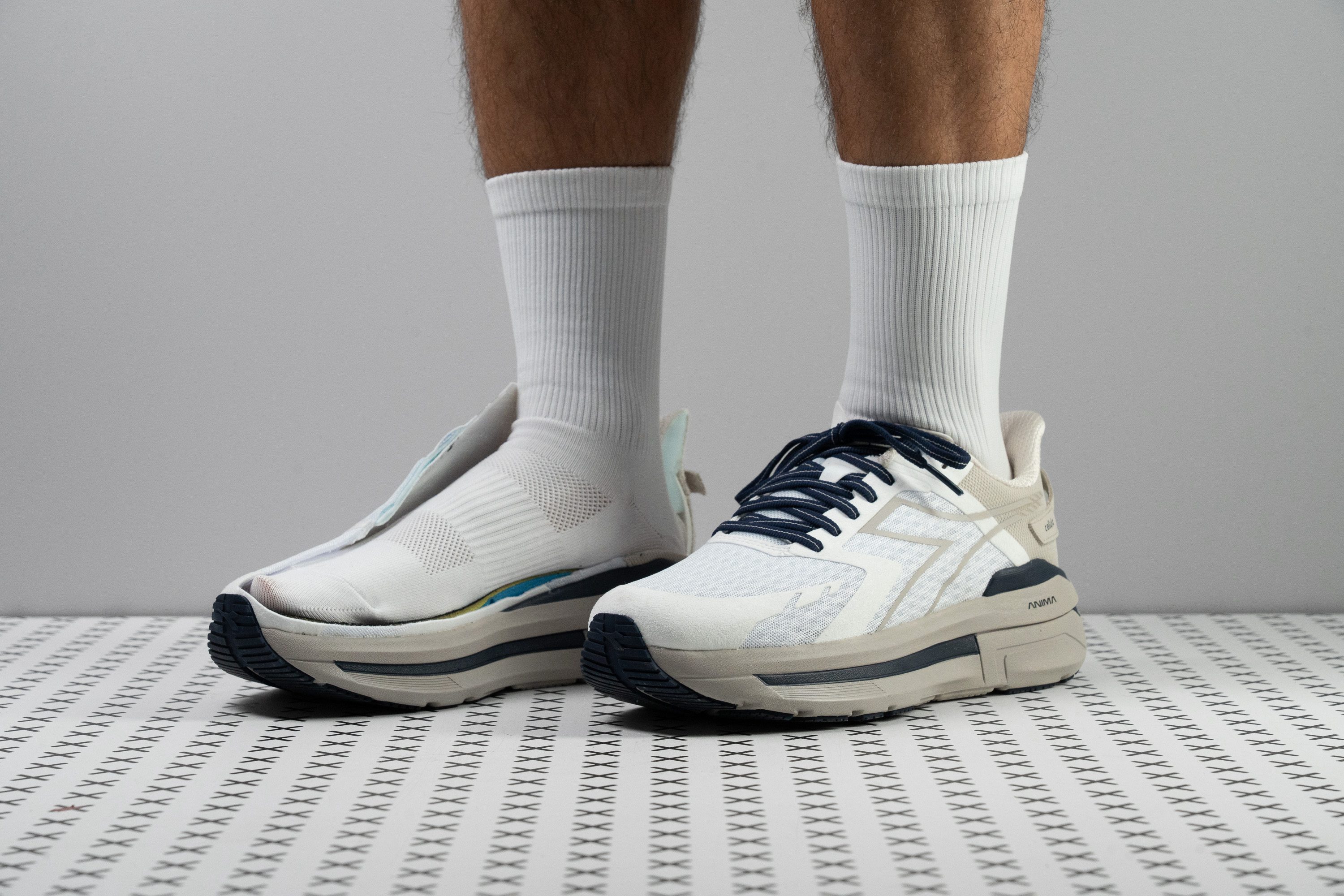Our verdict
Pros
- Premium materials
- Outstanding long-term durability
- Soft and comfortable ride
- Exceptional heel stability
- Max-stack cushioning
- Reliable all-weather grip
- Unique retro styling
- Traditional rocker profile
Cons
- Pricier than competitors
- Lacks flexibility
- Not a responsive ride at all
- Narrow fit
Audience verdict
Comparison
The most similar running shoes compared
+ + Add a shoe | |||||
|---|---|---|---|---|---|
| Audience score | 87 Great! | 84 Good! | 85 Good! | 92 Superb! | |
| Price | $170 | $160 | $160 | $150 | |
| Pace | Daily running | Daily running | Daily running | Daily running | |
| Shock absorption | High | High | High | High | |
| Energy return | Low | Low | Low | Moderate | |
| Traction | High | High | High | High | |
| Arch support | Neutral | Neutral | Neutral | Neutral | |
| Weight lab Weight brand | 9.8 oz / 278g 9.9 oz / 280g | 9.7 oz / 276g 9.7 oz / 275g | 10.7 oz / 303g 10.8 oz / 306g | 11.4 oz / 322g | |
| Drop lab Drop brand | 7.2 mm 5.0 mm | 8.0 mm 5.0 mm | 7.3 mm 6.0 mm | 8.8 mm 6.0 mm | |
| Strike pattern | Mid/forefoot | HeelMid/forefoot | Mid/forefoot | HeelMid/forefoot | |
| Size | Slightly small | True to size | True to size | True to size | |
| Midsole softness | Soft | Soft | Soft | Soft | |
| Difference in midsole softness in cold | Big | Normal | Normal | Normal | |
| Toebox durability | Decent | Bad | Decent | Decent | |
| Heel padding durability | Good | Good | Good | Good | |
| Outsole durability | Good | Good | Good | Good | |
| Breathability | Moderate | Moderate | Moderate | Moderate | |
| Width / fit | Narrow | Medium | Medium | Medium | |
| Toebox width | Medium | Medium | Medium | Narrow | |
| Stiffness | Stiff | Moderate | Stiff | Moderate | |
| Torsional rigidity | Stiff | Stiff | Stiff | Stiff | |
| Heel counter stiffness | Stiff | Moderate | Stiff | Stiff | |
| Heel lab Heel brand | 41.9 mm 38.0 mm | 38.7 mm 38.0 mm | 38.5 mm 39.0 mm | 41.7 mm 42.0 mm | |
| Forefoot lab Forefoot brand | 34.7 mm 33.0 mm | 30.7 mm 33.0 mm | 31.2 mm 33.0 mm | 32.9 mm 36.0 mm | |
| Widths available | Normal | NormalWide | NormalWideX-Wide | NormalWide | |
| Orthotic friendly | ✓ | ✓ | ✓ | ✓ | |
| Season | All seasons | All seasons | All seasons | All seasons | |
| Removable insole | ✓ | ✓ | ✓ | ✓ | |
| Ranking | #148 Top 40% | #230 Bottom 37% | #220 Bottom 40% | #11 Top 3% | |
| Popularity | #283 Bottom 23% | #197 Bottom 46% | #25 Top 7% | #30 Top 9% |
Who should buy
After completing our full round of lab tests and test runs, we concluded that the Cellula is a solid choice for:
- Runners with narrow feet seeking a daily trainer made from premium-quality materials
- Fans of retro-inspired designs who want a max-stack shoe that can also serve as a stylish sneaker.
- Those willing to spend more for exceptional durability and top-tier craftsmanship.
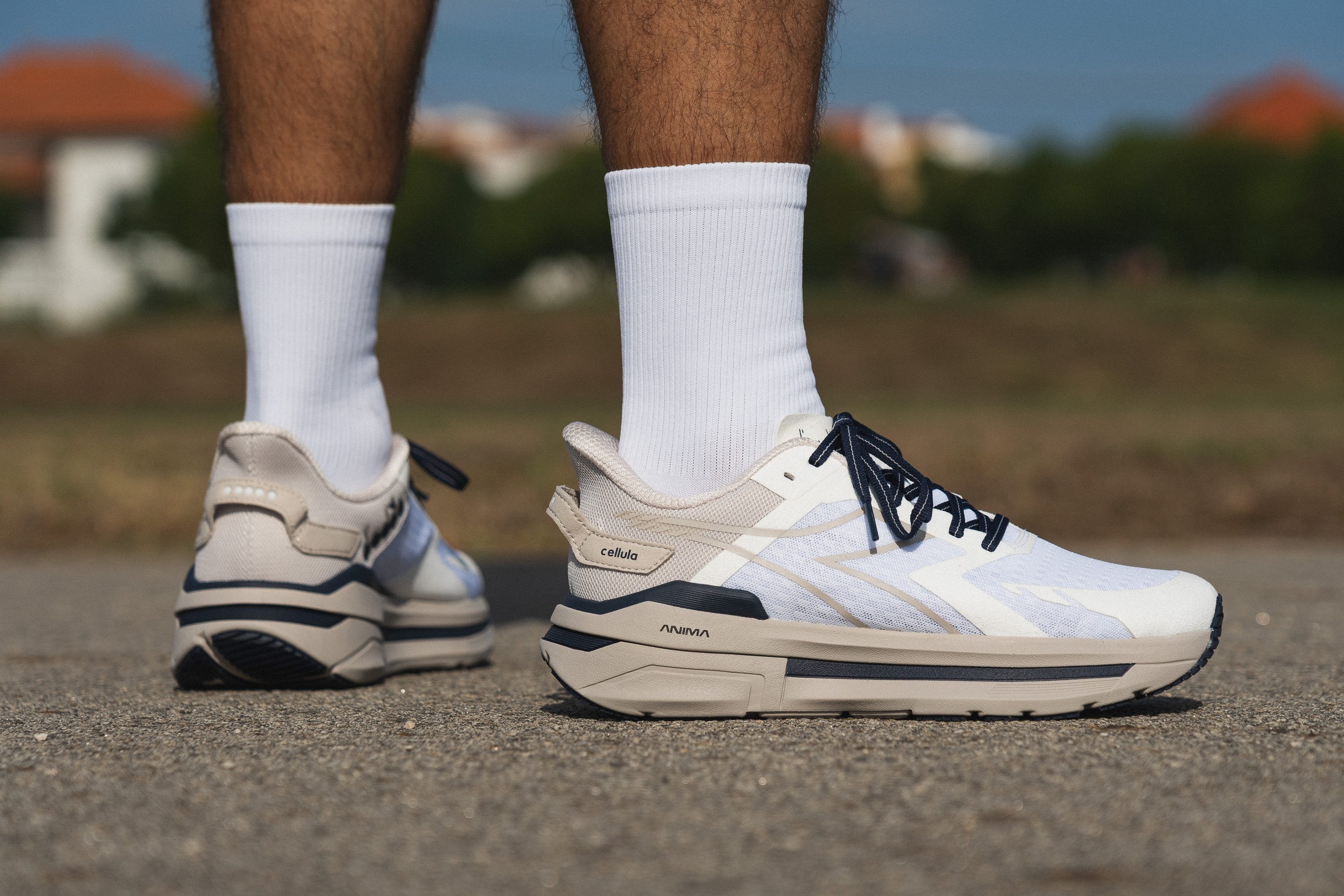
Who should NOT buy
We do not recommend the cellula for runners chasing a lively, speed-oriented ride. After lab testing, we found its energy return surprisingly low. Shoes like the Adidas Adizero EVO SL or Under Armour Infinite Elite 2 deliver a much bouncier experience with similar stack heights.
We also believe the narrow toebox is a major drawback. In our experience, it feels restrictive for those who enjoy a roomy fit, and we think better options exist, like the Adidas Ultraboost 5 or ASICS Noosa Tri 16.
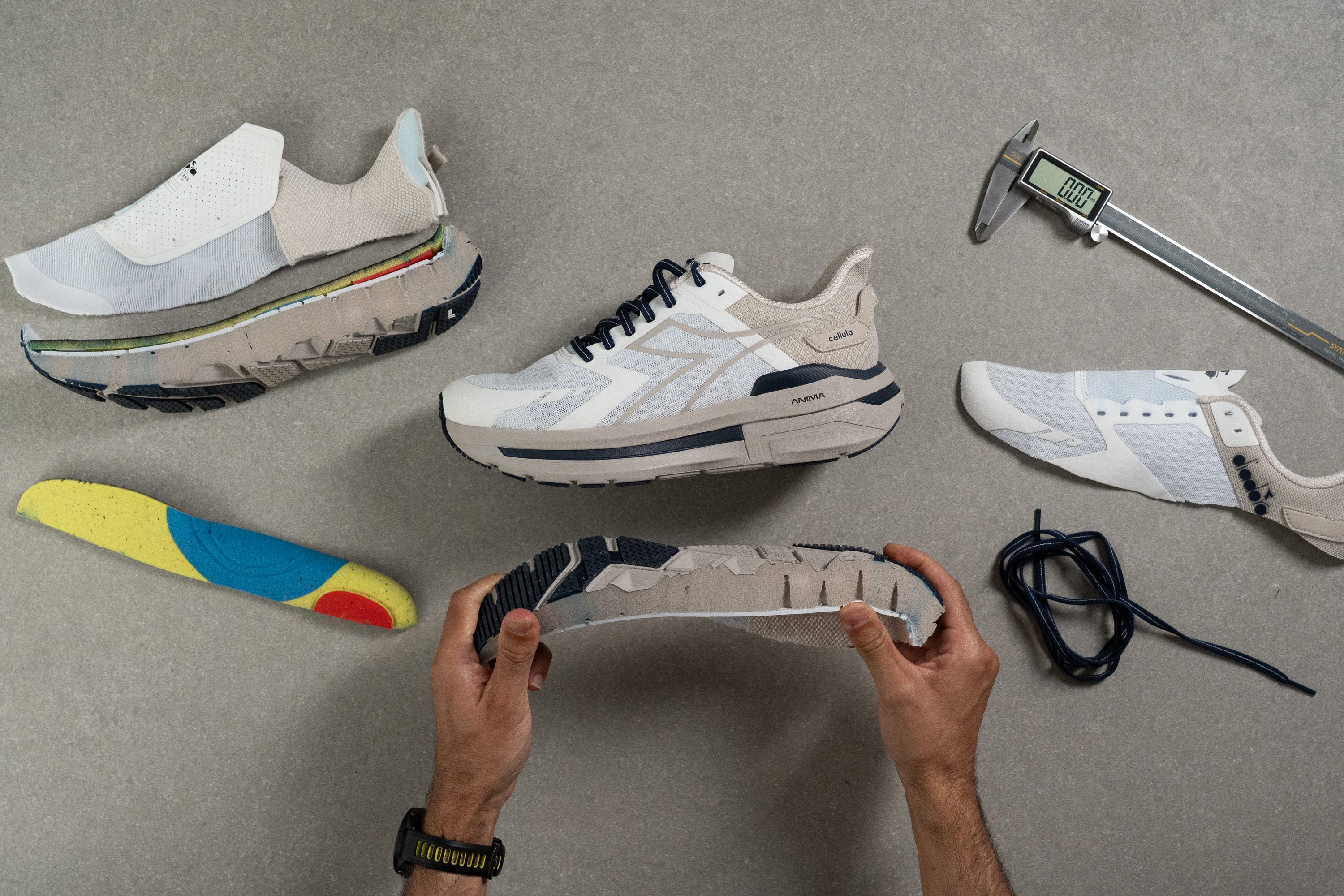
Cushioning
Shock absorption
The Diadora Cellula delivers solid shock absorption for heel strikers, handling both short efforts and long runs with ease thanks to its 132 SA cushioning. Remarkably, the forefoot nearly matches the heel, boasting a massive 128 SA that blows past the average.
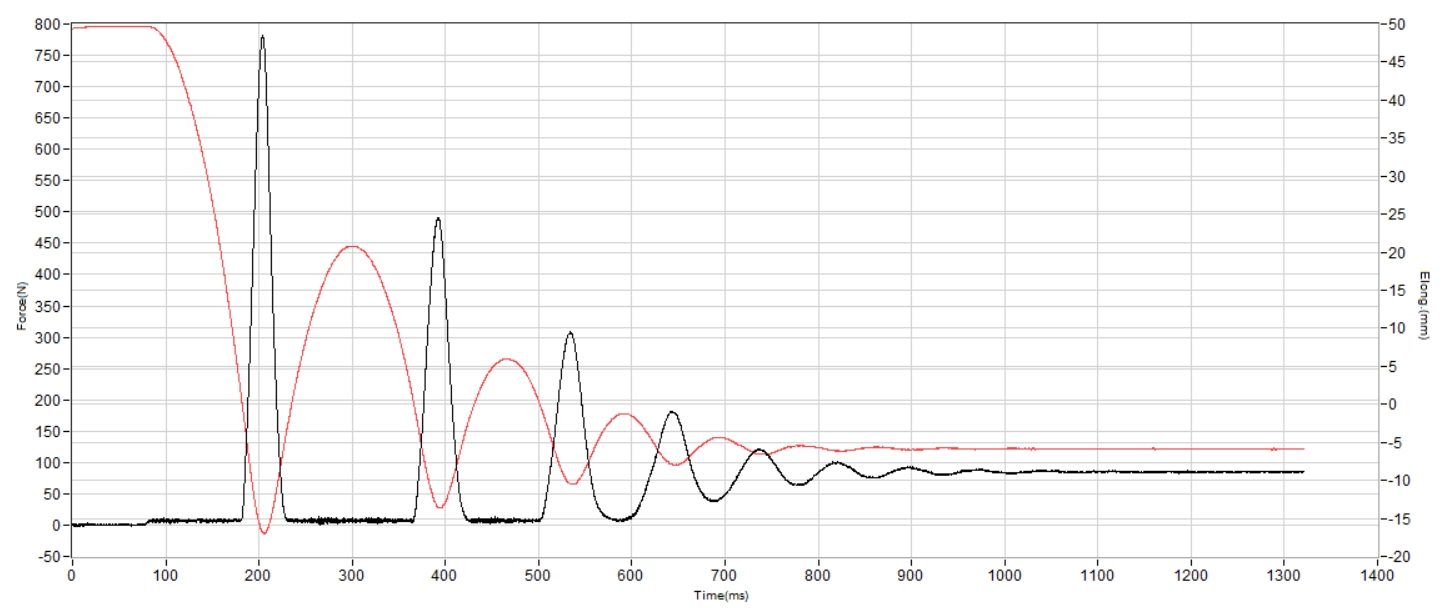
| Cellula | 132 SA |
| Average | 129 SA |
Energy return
Energy return is one of the Cellula’s weakest points, much like we found with the Diadora Atomo Star in our lab. Here, the EVA-based ANIMA foam delivered just 48.7% in the heel and 51.6% in the forefoot, which is far below most competitors and definitely not what you’d expect for this price.
| Cellula | 48.7% |
| Average | 58.6% |
Heel stack
Despite not appearing that tall before we cut the Cellula in half, we were amazed to find a 41.9 mm stack height.
This firmly places the Cellula in max-stack daily trainer territory, joining models like the Hoka Clifton 10 in what seems to be the new standard for running shoes.
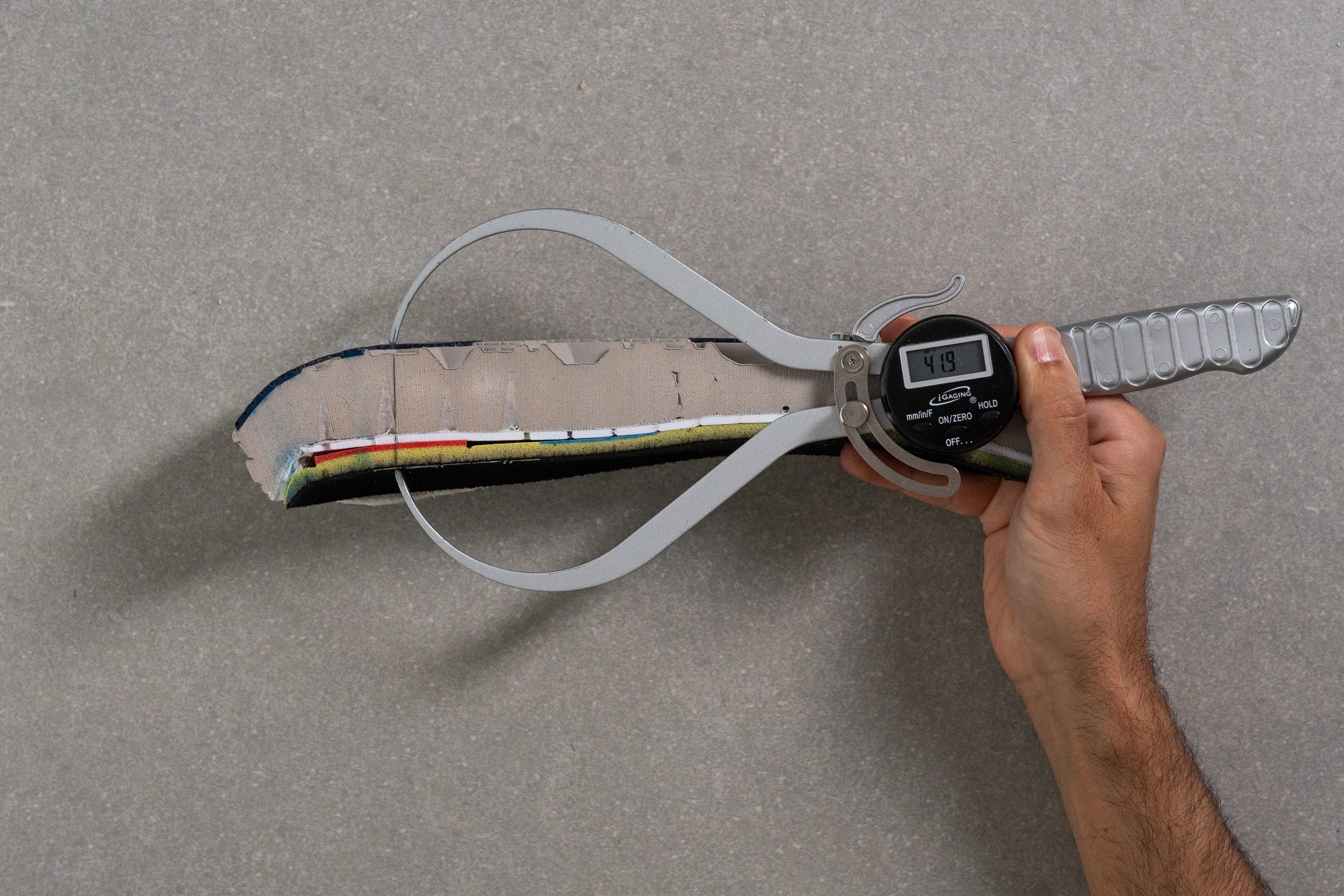
| Cellula | 41.9 mm |
| Average | 34.8 mm |
Forefoot stack
If the heel impressed you, wait for the forefoot: we measured a substantial 34.7 mm of stack height here.
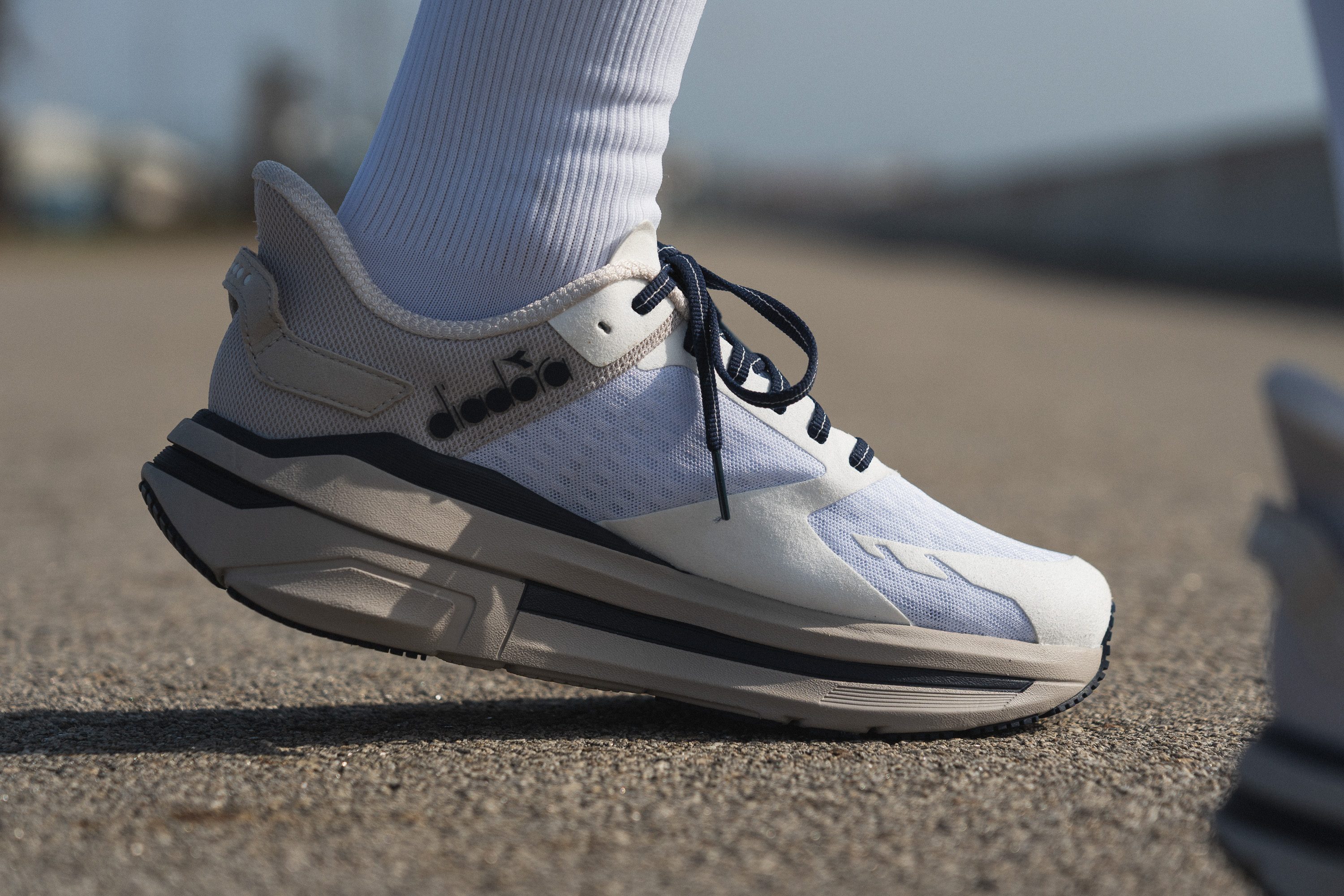
Given the already high shock absorption in this area, we think this shoe is perfect for runners who want maximum foam under the ball of the foot and aren’t concerned about ground feel or a proprioception-rich ride.
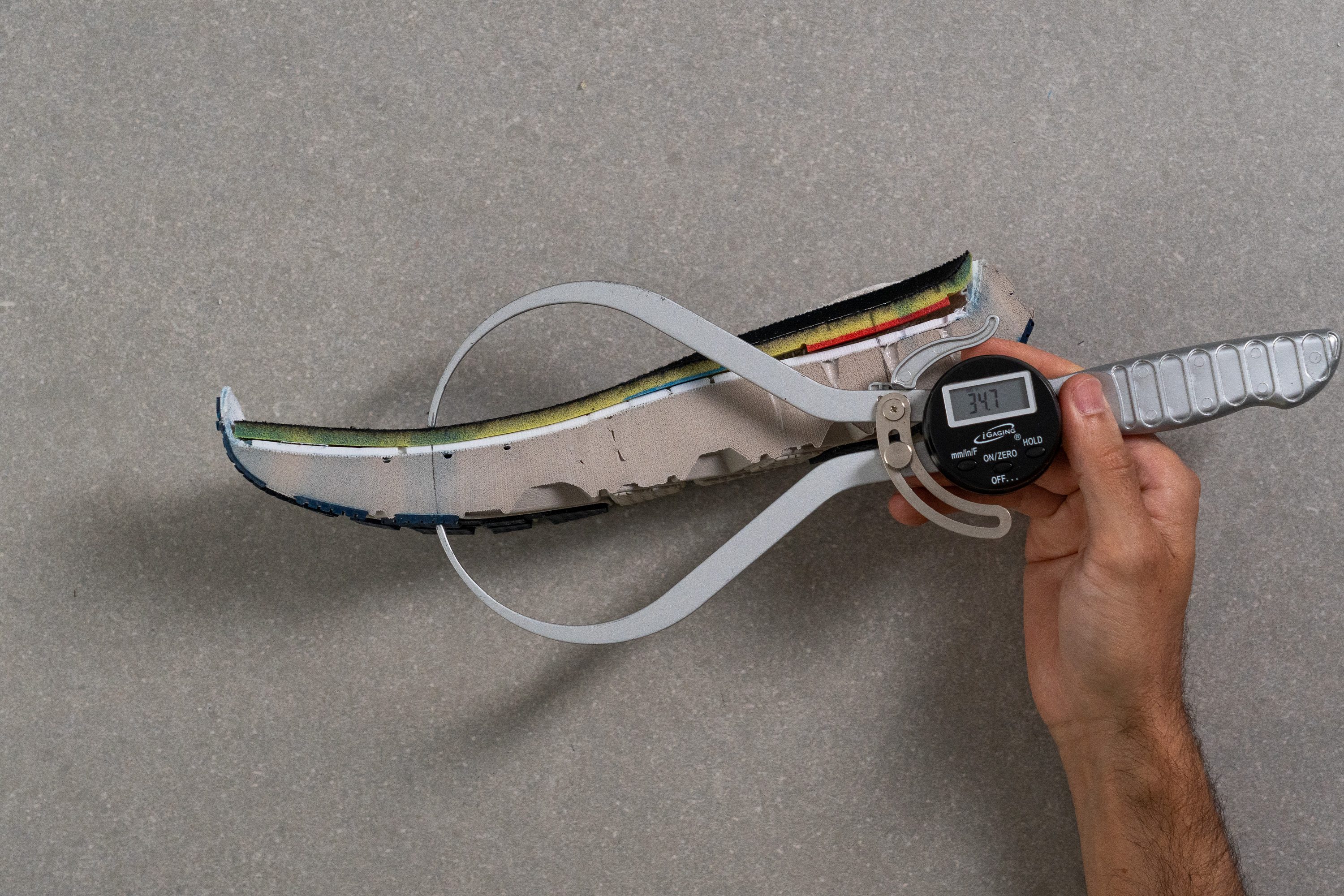
| Cellula | 34.7 mm |
| Average | 26.2 mm |
Drop
Diadora lists the Cellula with a 5 mm drop, but we measured it at 7.2 mm. This remains a moderate drop and won’t significantly affect the ride, especially given the exceptionally high forefoot stack.
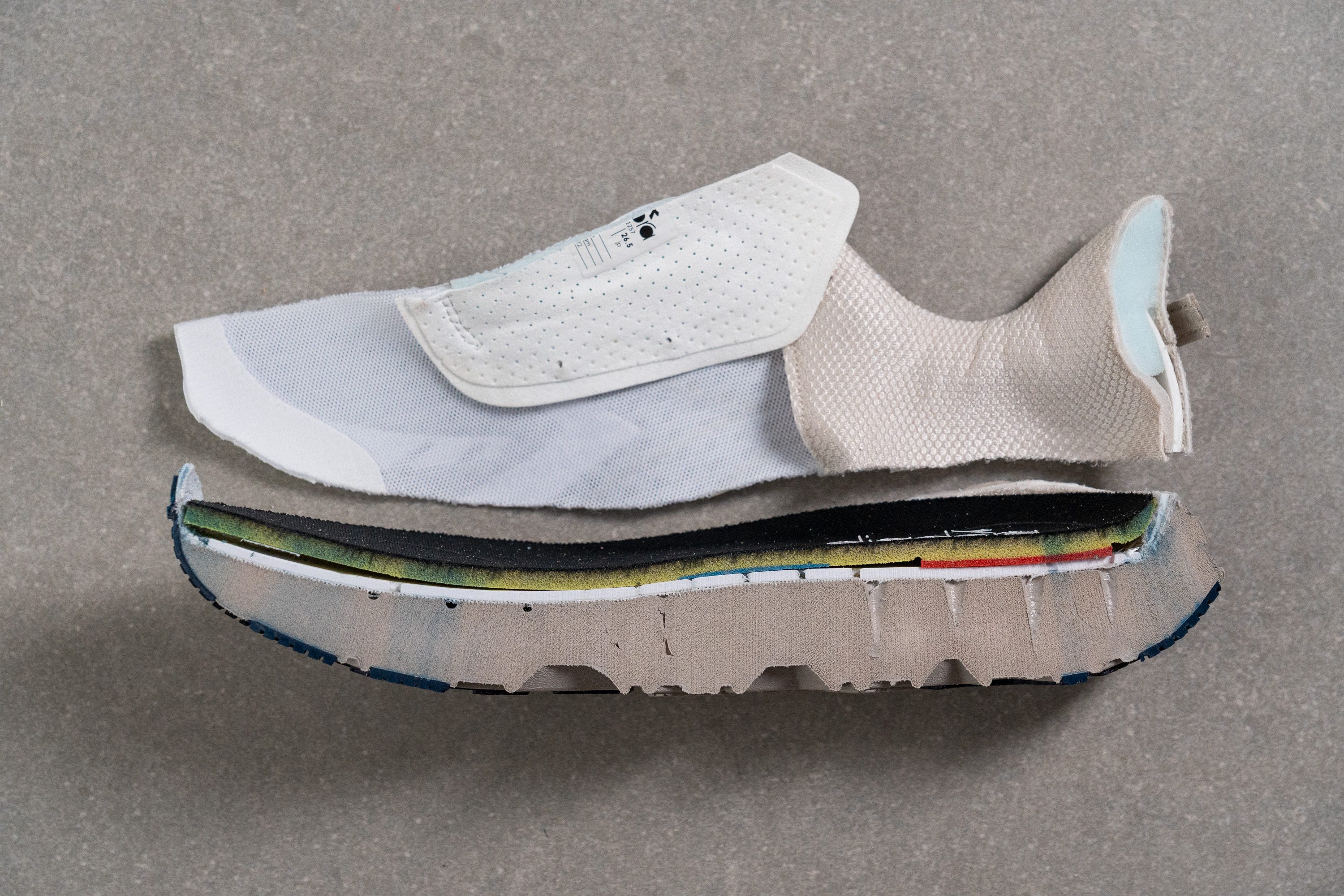
| Cellula | 7.2 mm |
| Average | 8.6 mm |
Midsole softness
Despite its high price, the Cellula isn’t positioned as a premium model in Diadora’s lineup, which still reserves the top spot for shoes equipped with ANIMA N2 and ANIMA PBX foams. Instead, it relies on a more basic EVA compound simply named ANIMA.
This foam offers a notably soft ride at just 14.5 HA, cushioning landings comfortably during easy runs. However, as we’ve observed in our lab testing, it delivers limited energy return, making it less suitable for performance-driven sessions.
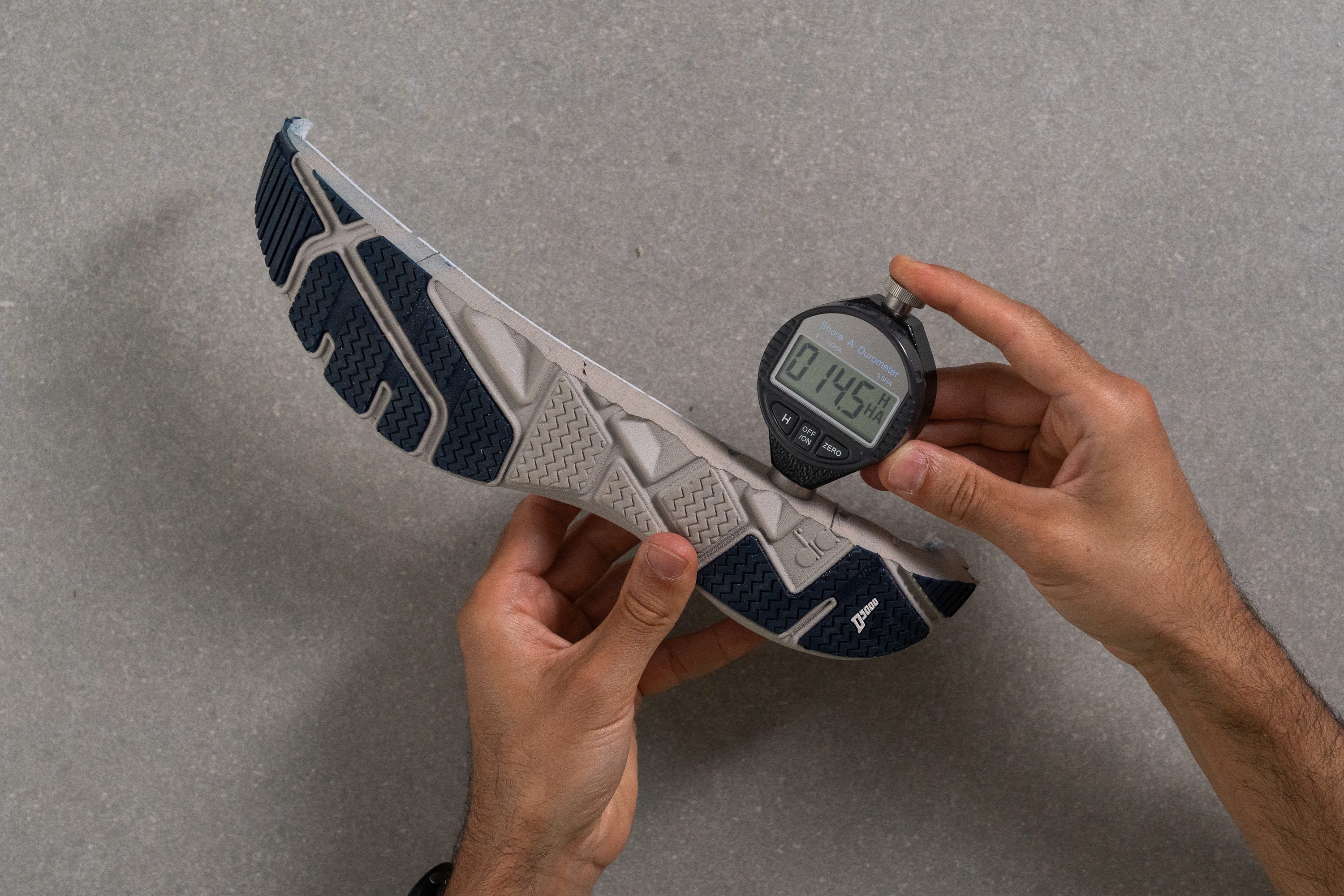
| Cellula | 14.5 HA |
| Average | 20.4 HA |
Rocker
From the side profile, the Diadora Cellula shows a classic rocker shape with minimal curvature in both the forefoot and heel.
This design keeps the platform relatively flat, making it an excellent choice for runners who prefer a more traditional feel underfoot rather than the aggressive, forward-rolling sensation of modern rockered shoes. And it definitely suits well the retro aesthetic of the shoe!
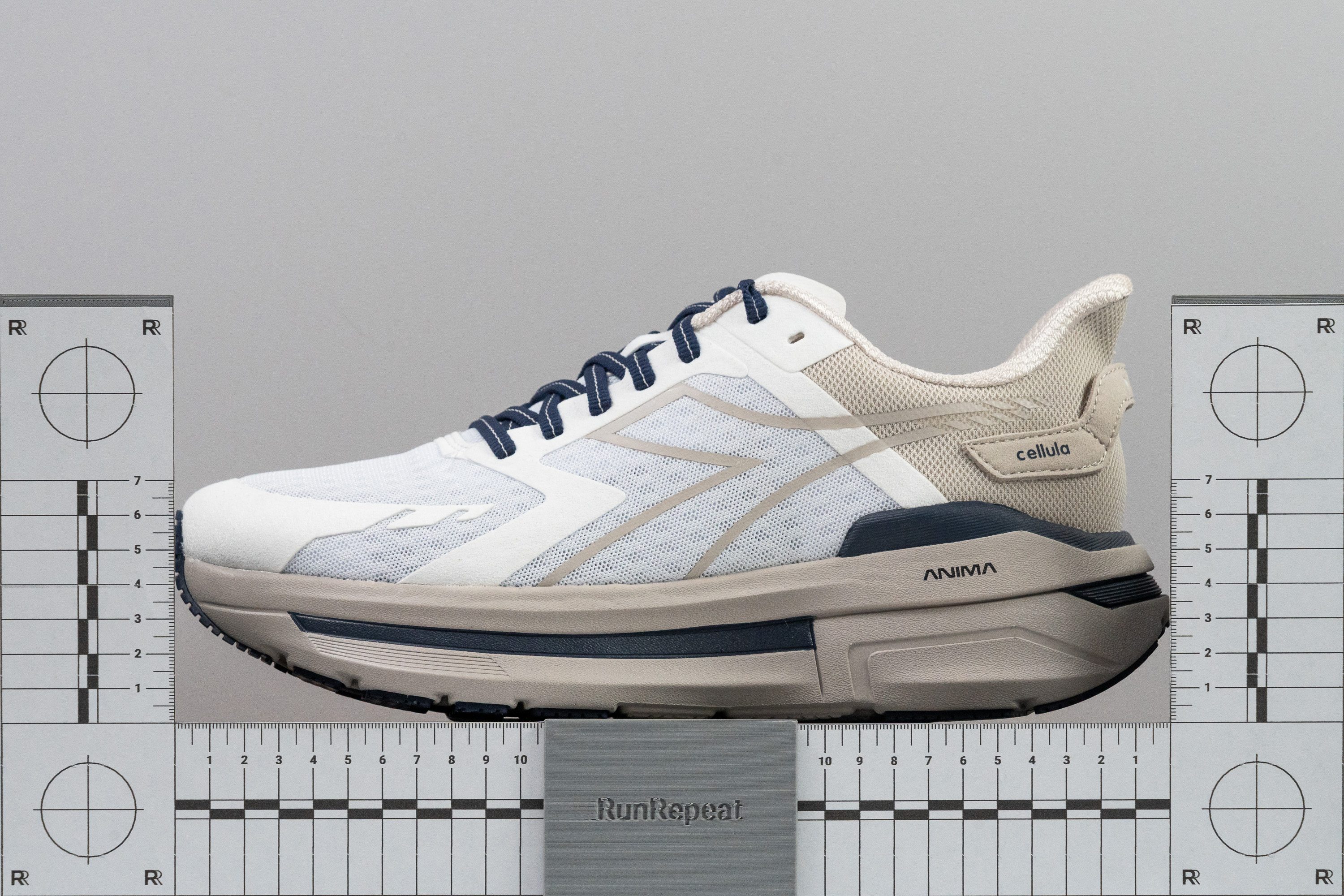
Size and fit
Size
Diadora Cellula fits slightly small (10 votes).
Width / Fit
Diadora, as a 100% Italian brand, often designs running shoes with a snug fit that works perfectly for runners with narrow or low-volume feet... but not for everyone else.
This holds true for the Cellula, as our cooled gel mold measured only 92.1 mm in width.
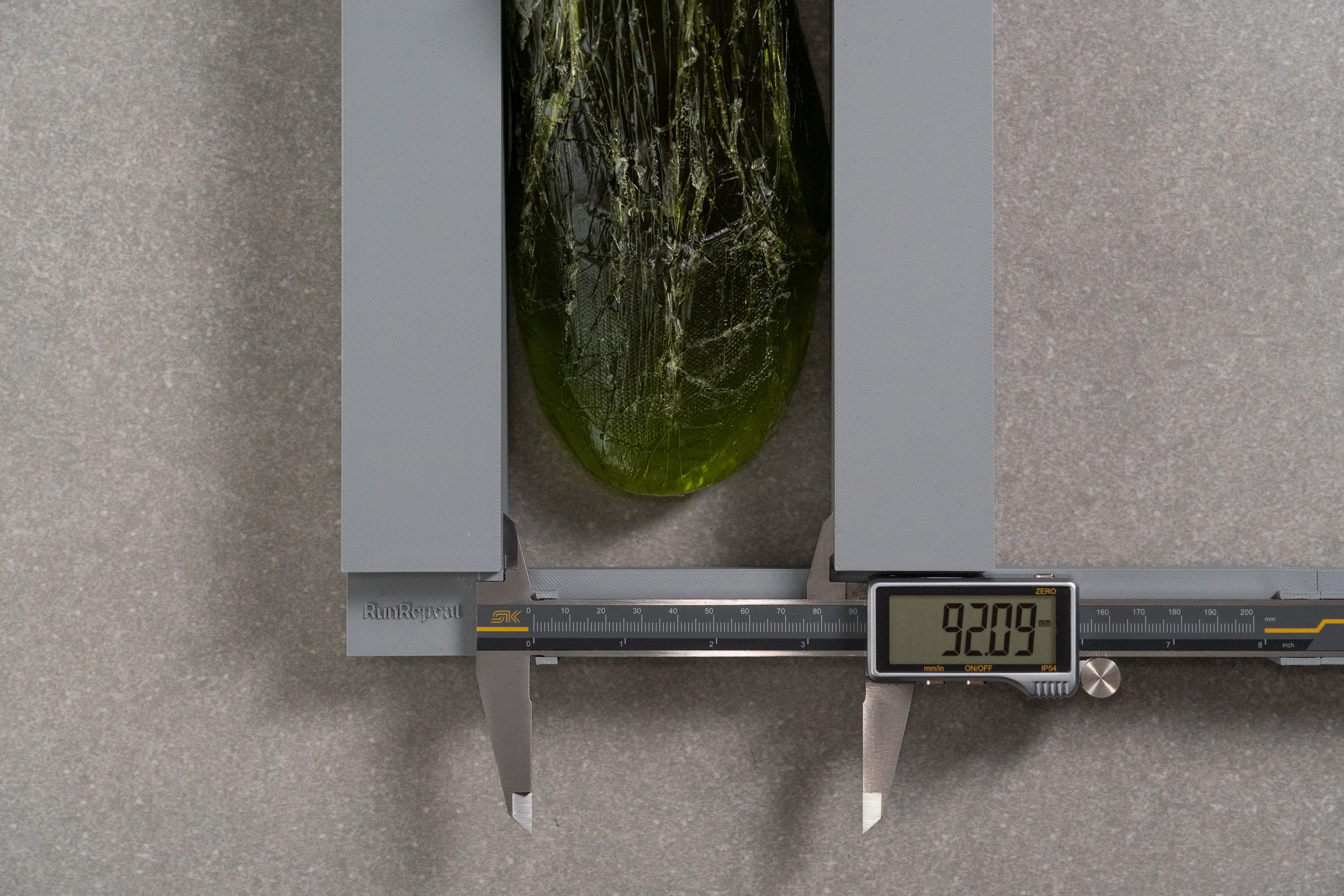
| Cellula | 92.1 mm |
| Average | 95.1 mm |
Toebox width
We took a second measurement in the toebox to better assess the Cellula’s fit, and true to its DNA, we found another below-average reading at 71.1 mm. It's clear that this shoe is best suited for runners with narrow feet.
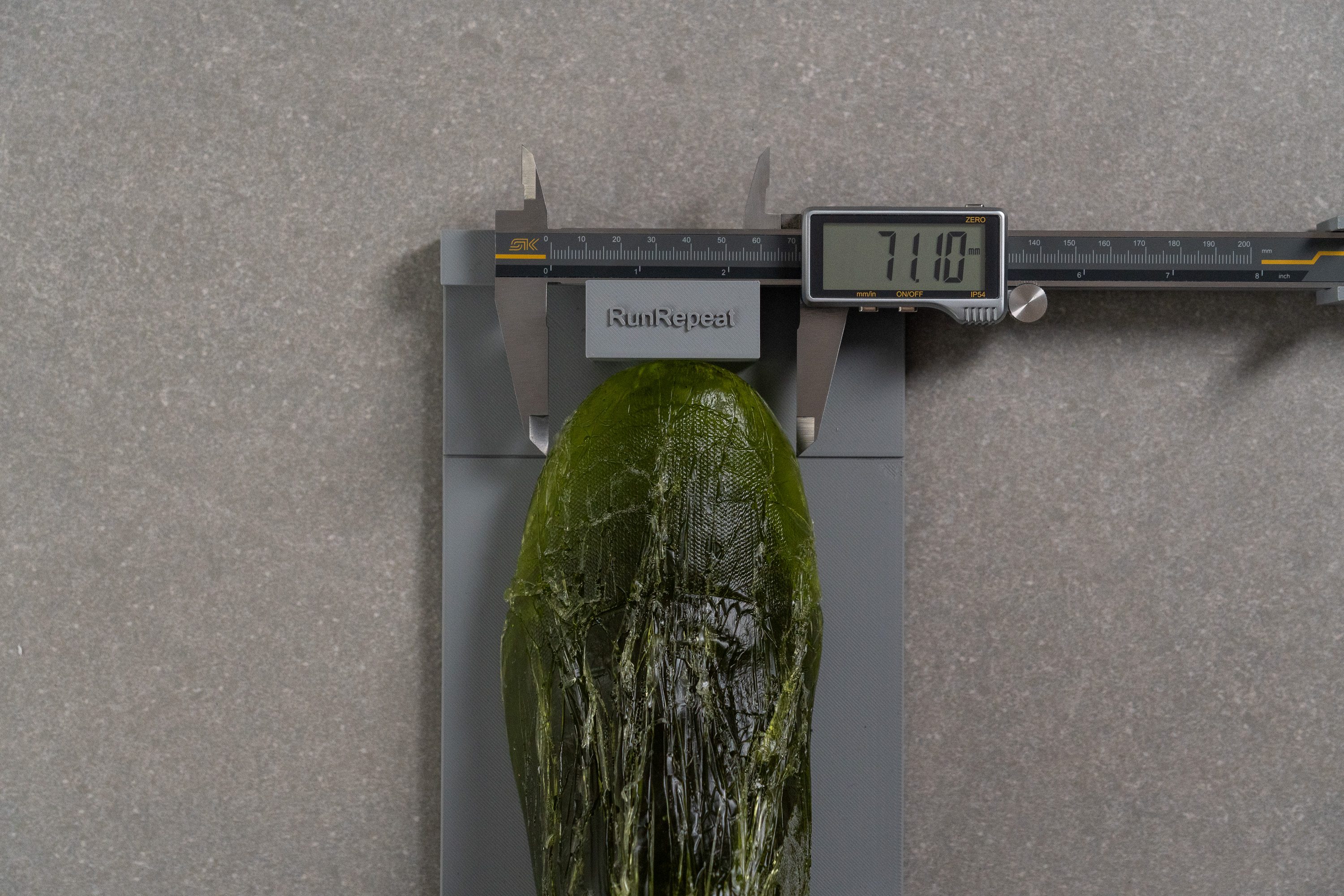
| Cellula | 71.1 mm |
| Average | 73.3 mm |
Toebox height
The toebox height is also quite low at 24.7 mm.
Runners with low-volume feet or those who don’t typically raise their big toe should be fine, but others might find this design quite restrictive.
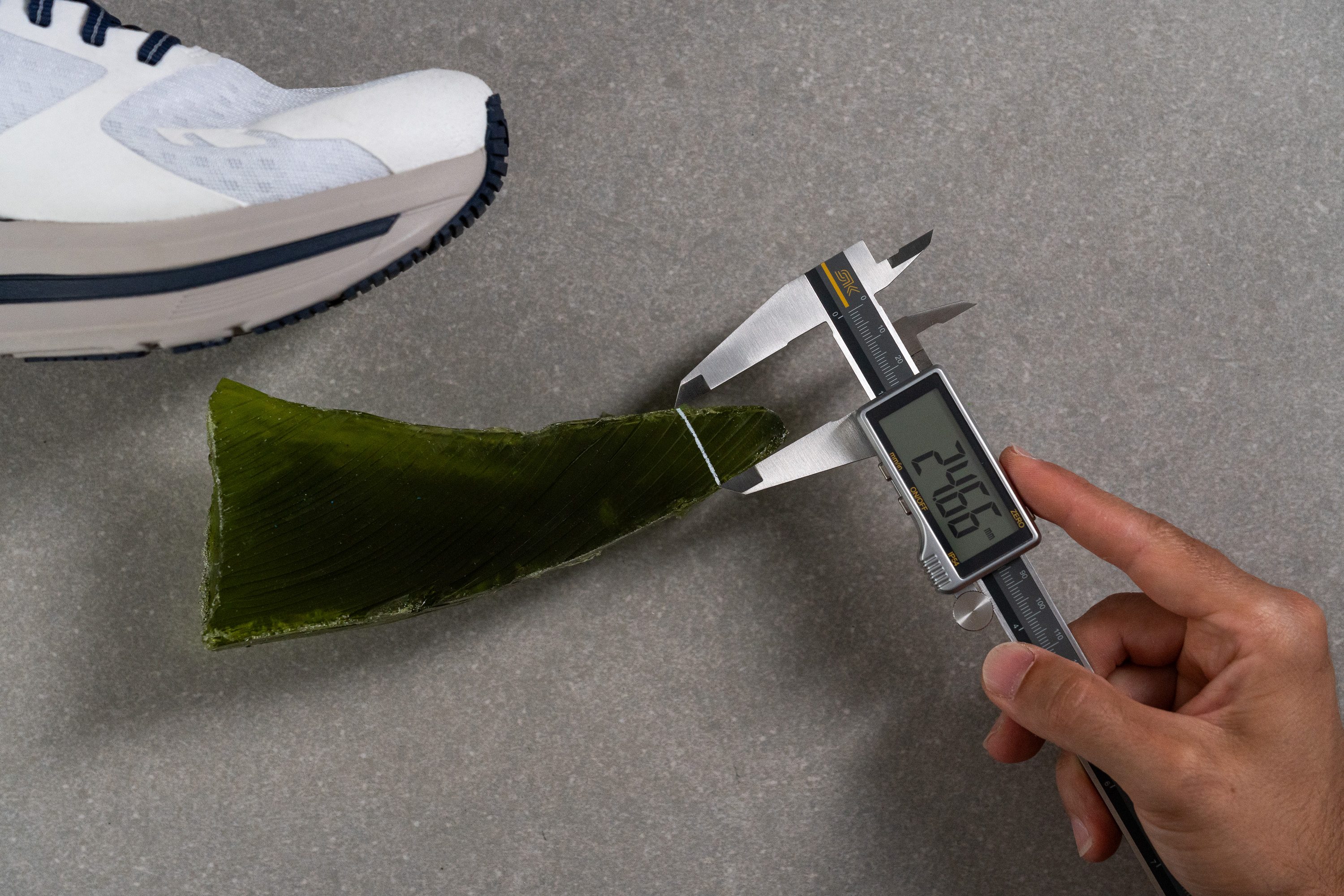
| Cellula | 24.7 mm |
| Average | 27.1 mm |
Traction / Grip
Traction test
We tested the Duratech 5000 rubber and found it scored an impressive 0.55 in our lab test. With this result, the Cellula offers reliable performance on both dry and rainy days throughout the year.
| Cellula | 0.55 |
| Average | 0.48 |
Outsole design
The outsole combines black Duratech 5000 rubber segments with some exposed areas to reduce weight. Rubber is placed in high-wear zones at the heel, midfoot, and forefoot, with deep horizontal and vertical grooves that work wonders to channel water away on rainy days.
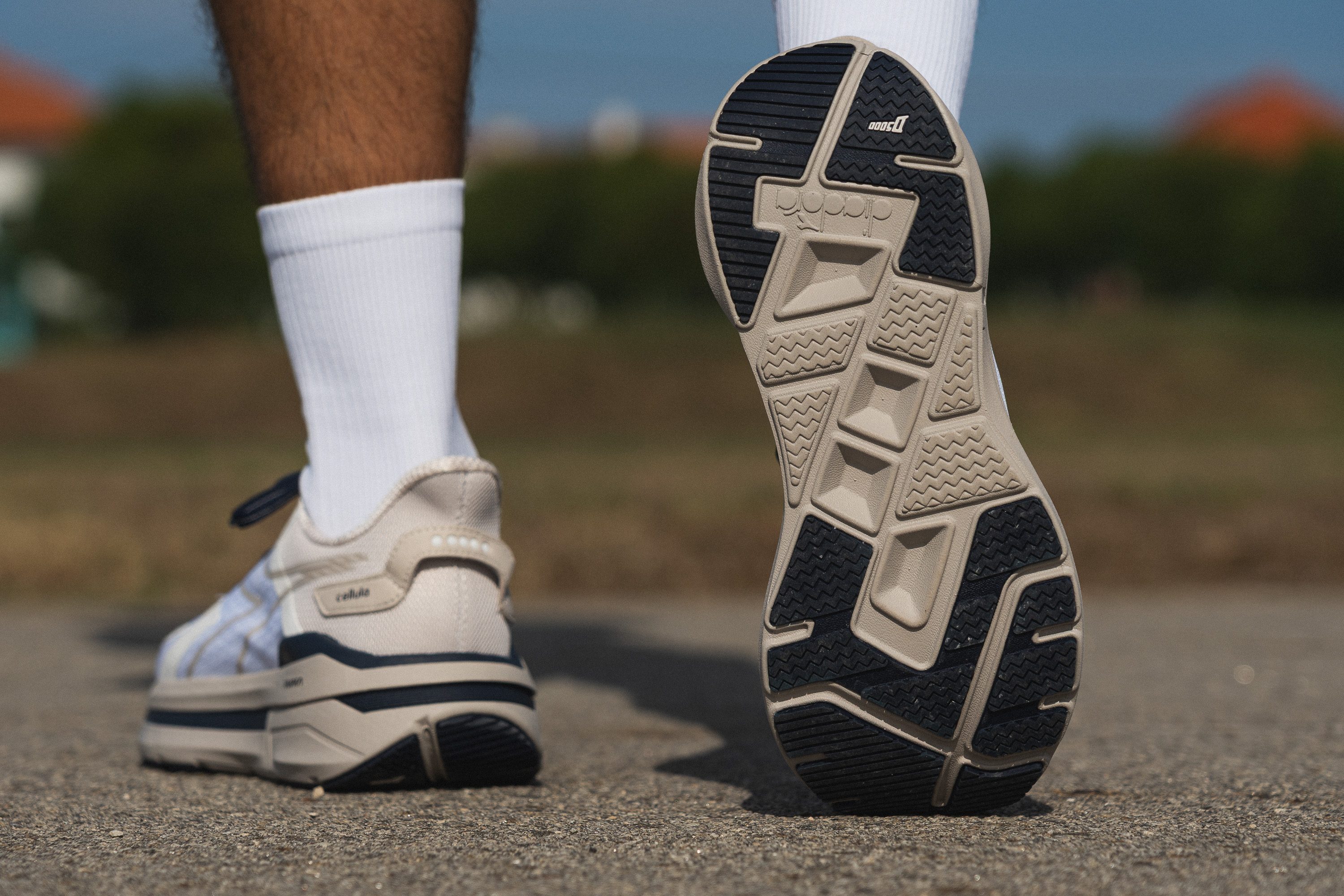
Flexibility / Stiffness
Despite featuring multiple grooves in the outsole, the Cellula is far from a flexible shoe. Its 17.2N score in our 30-degree bend test rivals that of some carbon-plated models, making it less appealing for runners who prefer a more natural feel underfoot.
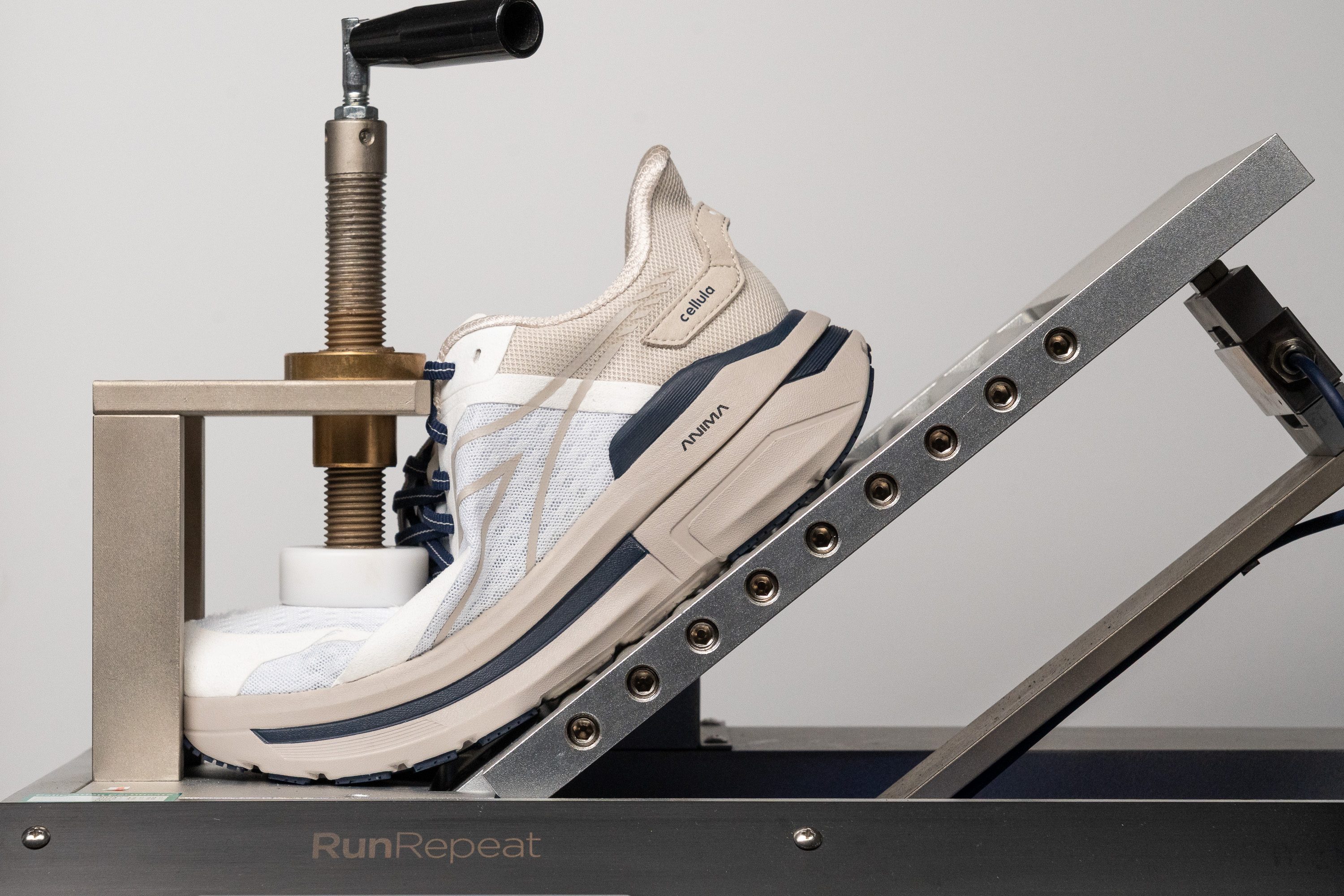
| Cellula | 17.2N |
| Average | 15.3N |
Weight
Despite its high stack height, Diadora managed to keep the Cellula’s weight at 9.8 oz (278g). While not remarkable and heavier than many rivals, the padded upper and retro design demand denser materials, yet it still stays under the 10-ounce mark.
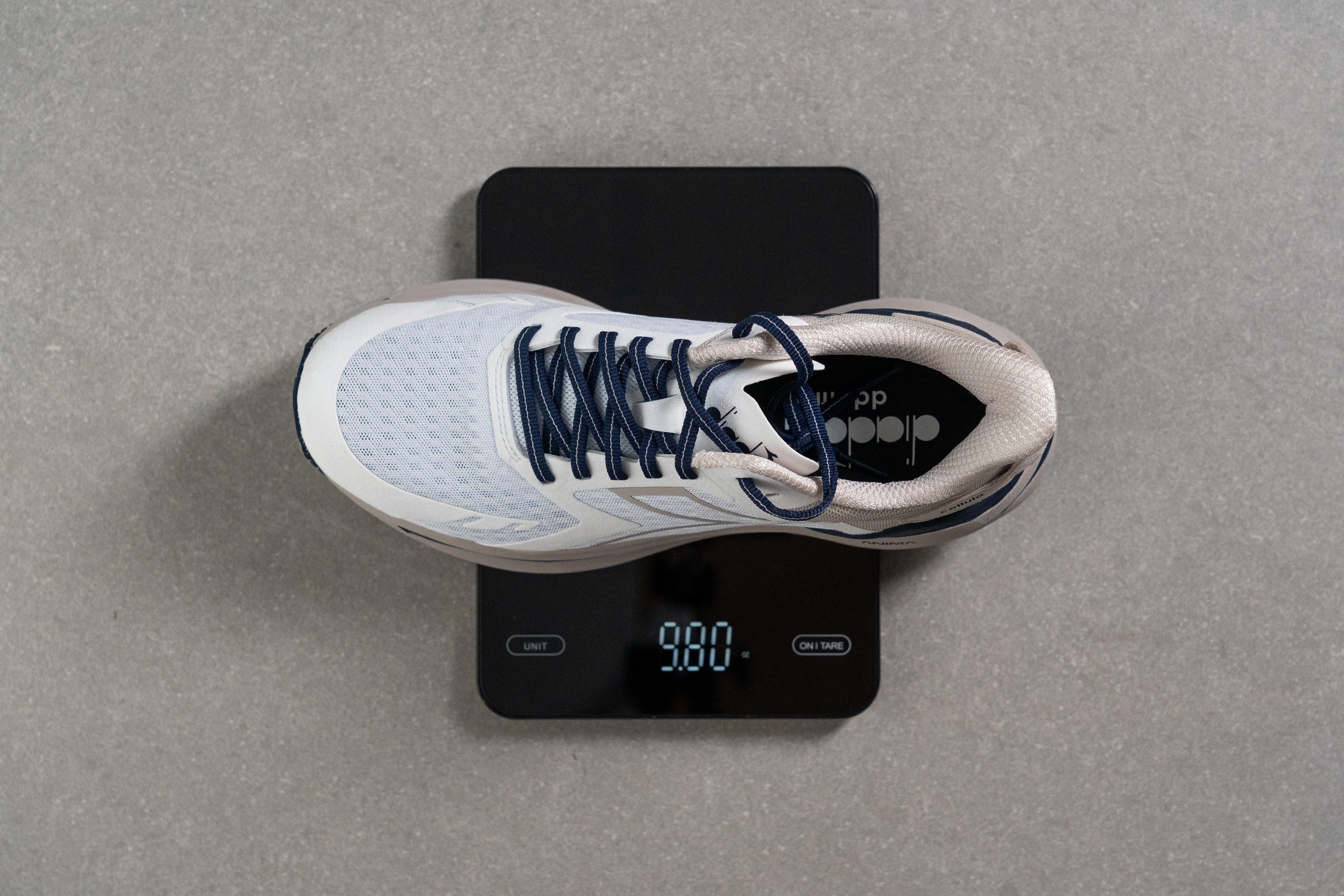
| Cellula | 9.8 oz (278g) |
| Average | 9.3 oz (264g) |
Breathability
The retro-inspired design of the Cellula might not appear highly breathable, yet it uses modern materials like a thin engineered mesh that should provide decent airflow.
To confirm, we ran our smoke machine test and recorded a 3/5 score. Well, that's likely a bit warm on the hottest days, but comfortable most of the year.
The upper combines thin sections with thicker overlays for structure and its retro-modern aesthetic, which slightly limits ventilation.
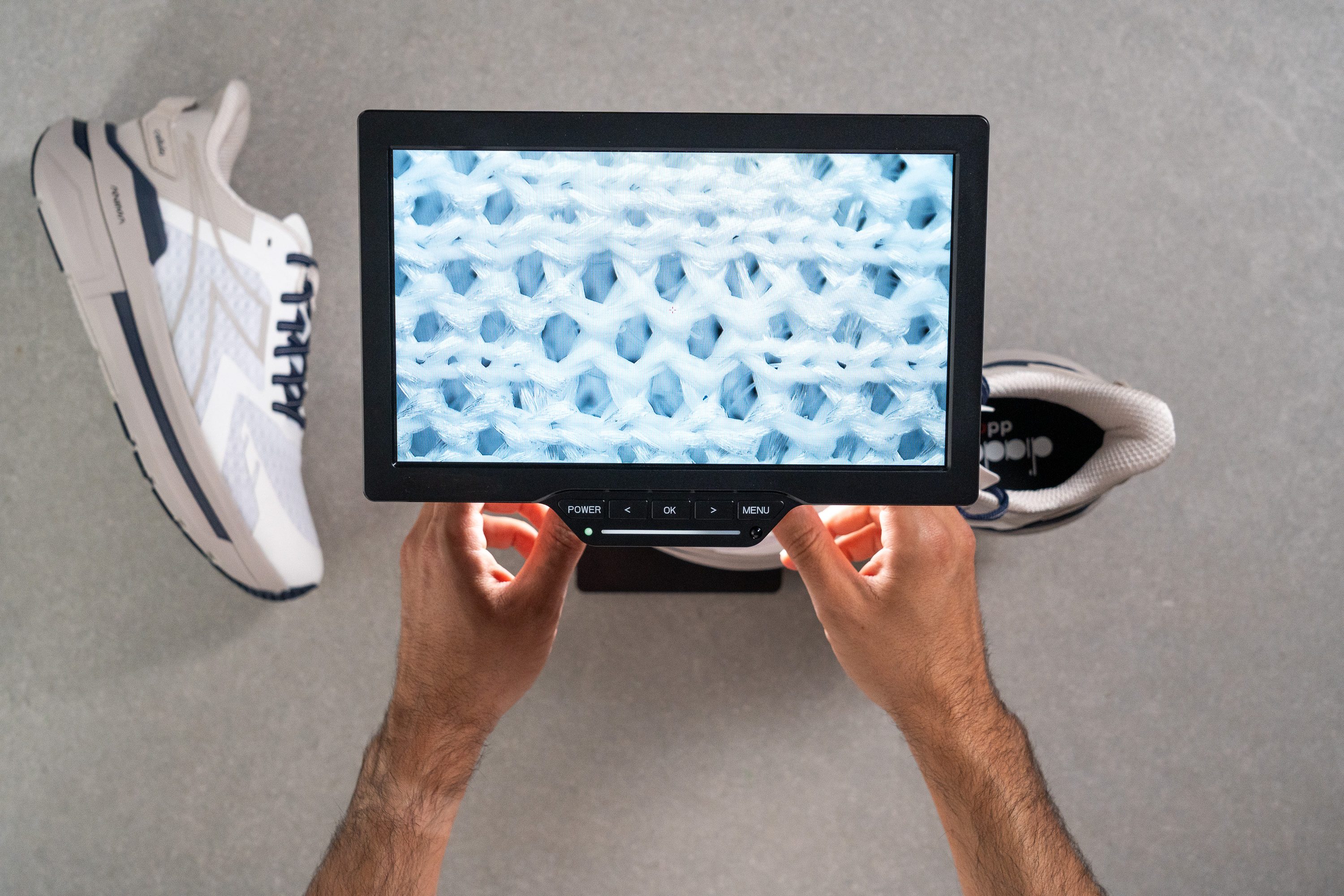
Under the digital microscope, we found the engineered mesh to be the same type used in many current daily trainers, showing that while the style is retro, the materials are modern.
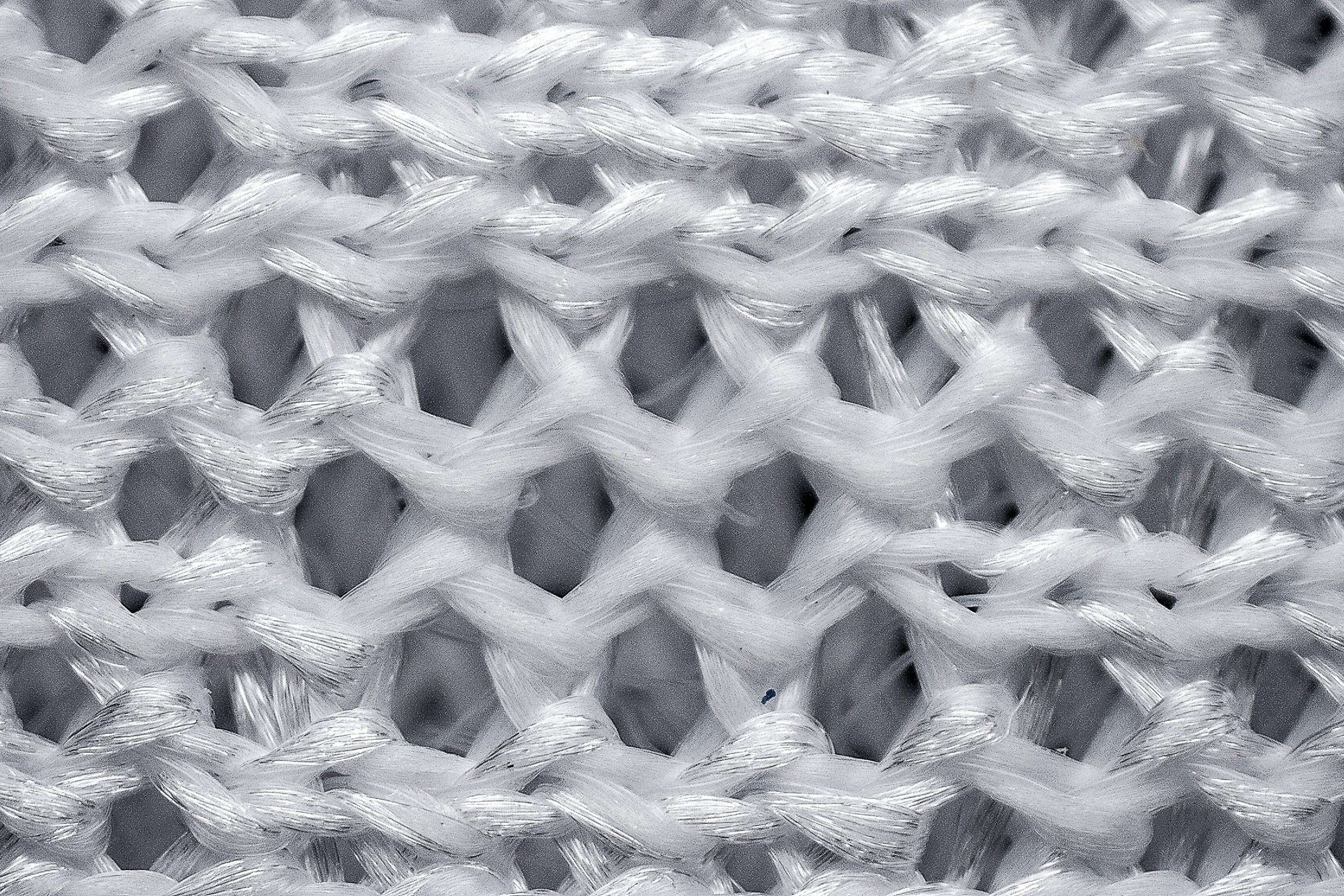
Handling the upper by hand, we were impressed by how thin the mesh actually is. Given this, the 3/5 result was surprising, though the absence of large ventilation holes clearly impacted the final score.
| Cellula | 3 |
| Average | 3.7 |
Stability
Lateral stability test
Thanks to its extreme rigidity, the Cellula delivers impressive stability despite its towering stack height. This effect is particularly evident for heel strikers, as the shoe’s rear is noticeably wider than its forefoot and it also features tall sidewalls hugging the heel on the sides.
Torsional rigidity
The Cellula ranks among the most rigid daily trainers we’ve tested with a 5/5 score, virtually impossible to twist or bend, delivering a feel reminiscent of supertrainers like the ASICS Superblast 2.
| Cellula | 5 |
| Average | 3.5 |
Heel counter stiffness
The heel counter is exceptionally rigid with another 5/5, which helps explain the shoe’s stable feel during heel-first landings. However, runners sensitive to ultra-stiff counters are unlikely to find this setup comfortable, even despite the Hoka-inspired design to reduce pressure on the tendon.
| Cellula | 5 |
| Average | 2.9 |
Midsole width - forefoot
When we measured the forefoot at 114.6 mm, it immediately stood out. Given the high stack height, we anticipated a wider platform, but the narrow toebox means Diadora didn’t need to extend the midsole width to ~120 mm to keep the foot stable.

| Cellula | 114.6 mm |
| Average | 114.4 mm |
Midsole width - heel
Conversely, the heel comes in at a substantial 98.3 mm. Its interior width matches other competitors, and with the stack height here exceeding 40 mm, the added width makes sense for us—though it does give the ride a slightly clunkier feel.
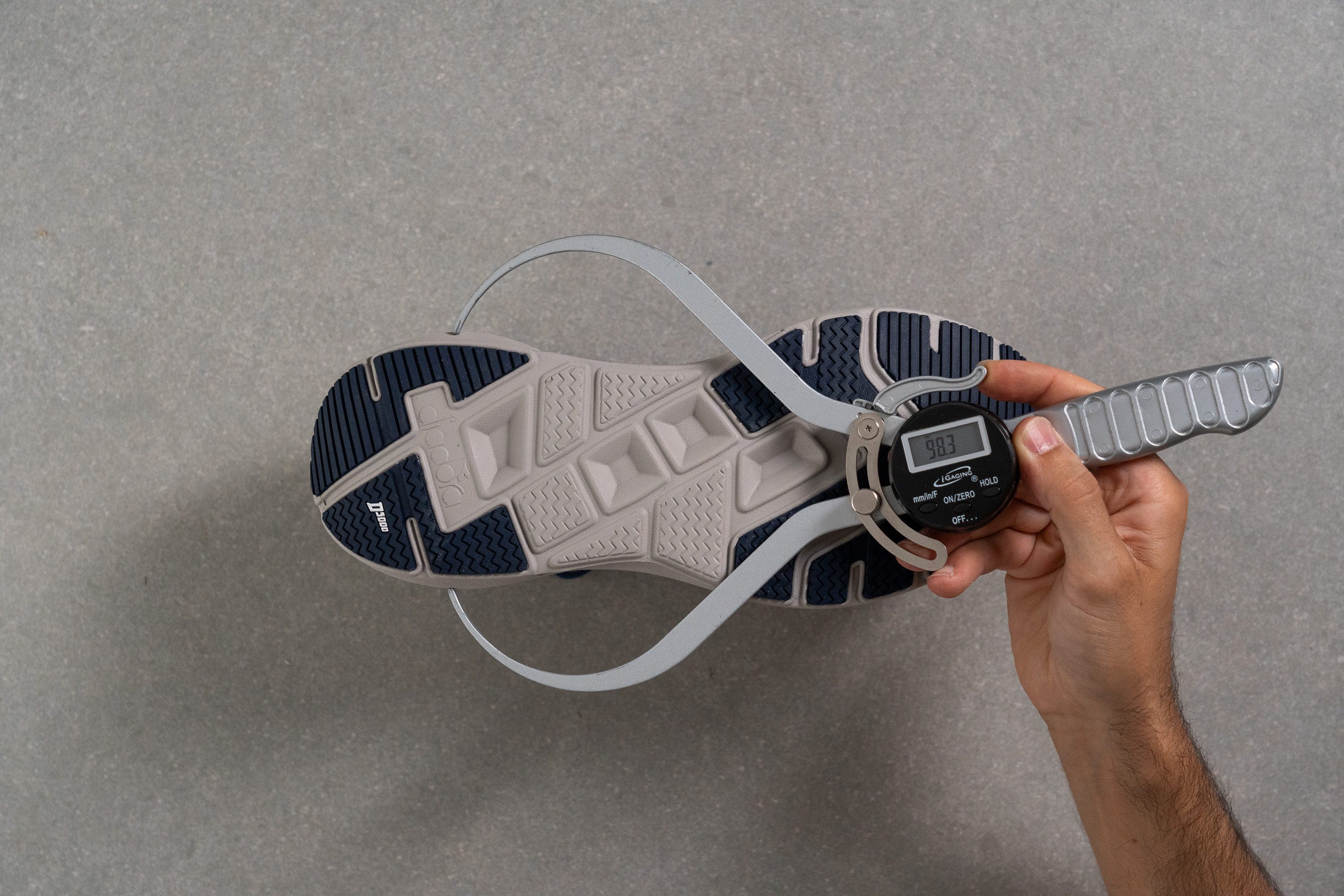
| Cellula | 98.3 mm |
| Average | 90.7 mm |
Durability
Toebox durability
Initially, we were concerned about the Cellula’s durability given its extremely thin engineered mesh. However, after subjecting it to our Dremel-based durability test, it earned a well-deserved 3/5 score, putting our worries to rest.
| Cellula | 3 |
| Average | 2.6 |
Heel padding durability
The heel padding absolutely aced our test, earning a flawless 5/5 score and leaving no doubt that the Cellula won’t be falling apart in this area anytime soon.
| Cellula | 5 |
| Average | 3.4 |
Outsole durability
The Duratech 5000 outsole excelled in our test, showing only 0.6 mm of wear and confirming durability as one of the Cellula’s biggest strengths—a crucial factor when investing in a high-priced shoe.
| Cellula | 0.6 mm |
| Average | 1.1 mm |
Outsole thickness
If there was any doubt about the outsole’s durability, Diadora addressed it with 2.9 mm of rubber. While slightly below the lab average, it’s more than sufficient for a shoe that performs this well against wear and tear.
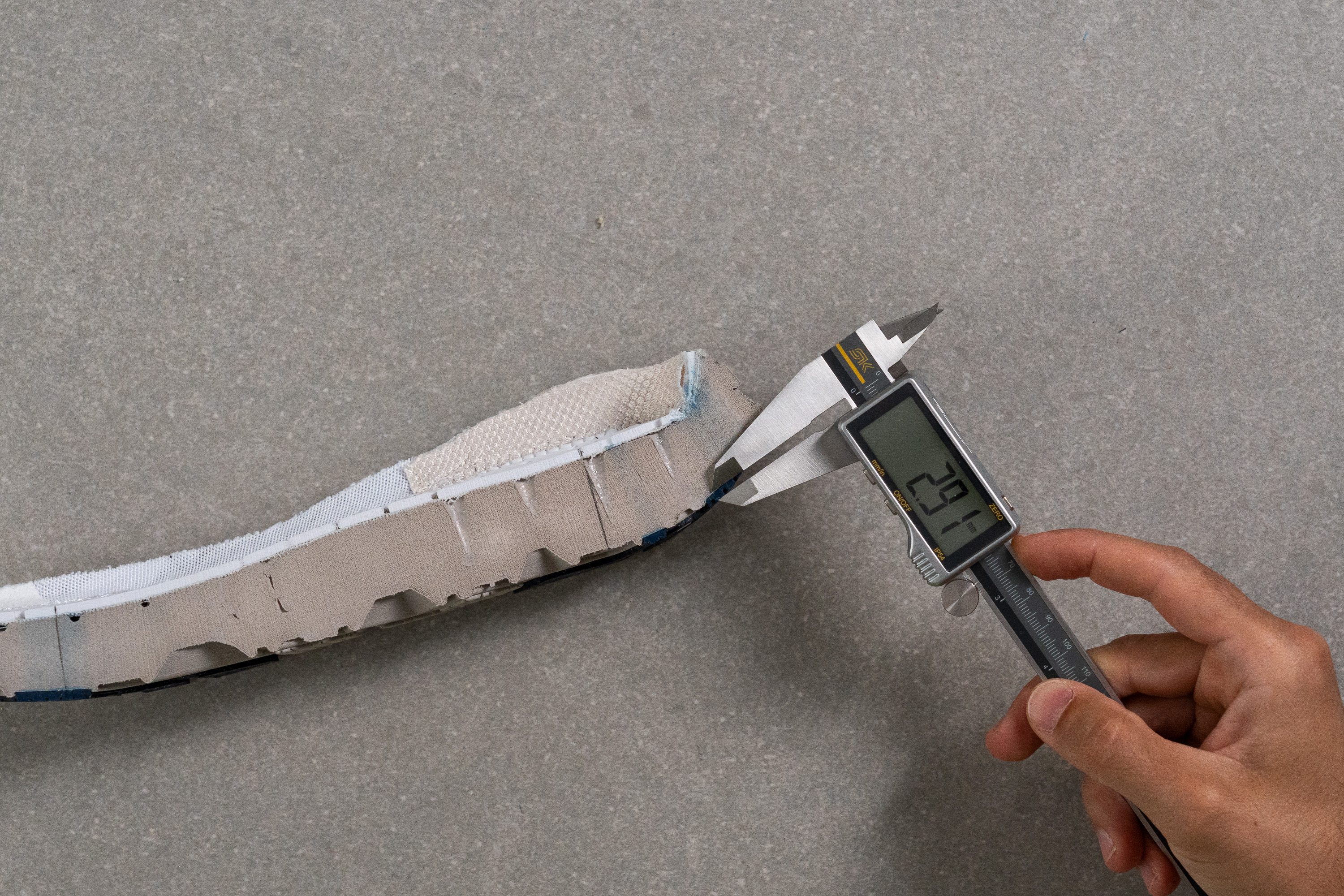
| Cellula | 2.9 mm |
| Average | 3.2 mm |
Misc
Insole thickness
The DDATTIVO insole reaches a substantial 7.5 mm in the heel, playing a key role in the shoe’s max-stack build. We also found it noteworthy that it features variable thickness, with the midfoot and forefoot offering a more average profile.
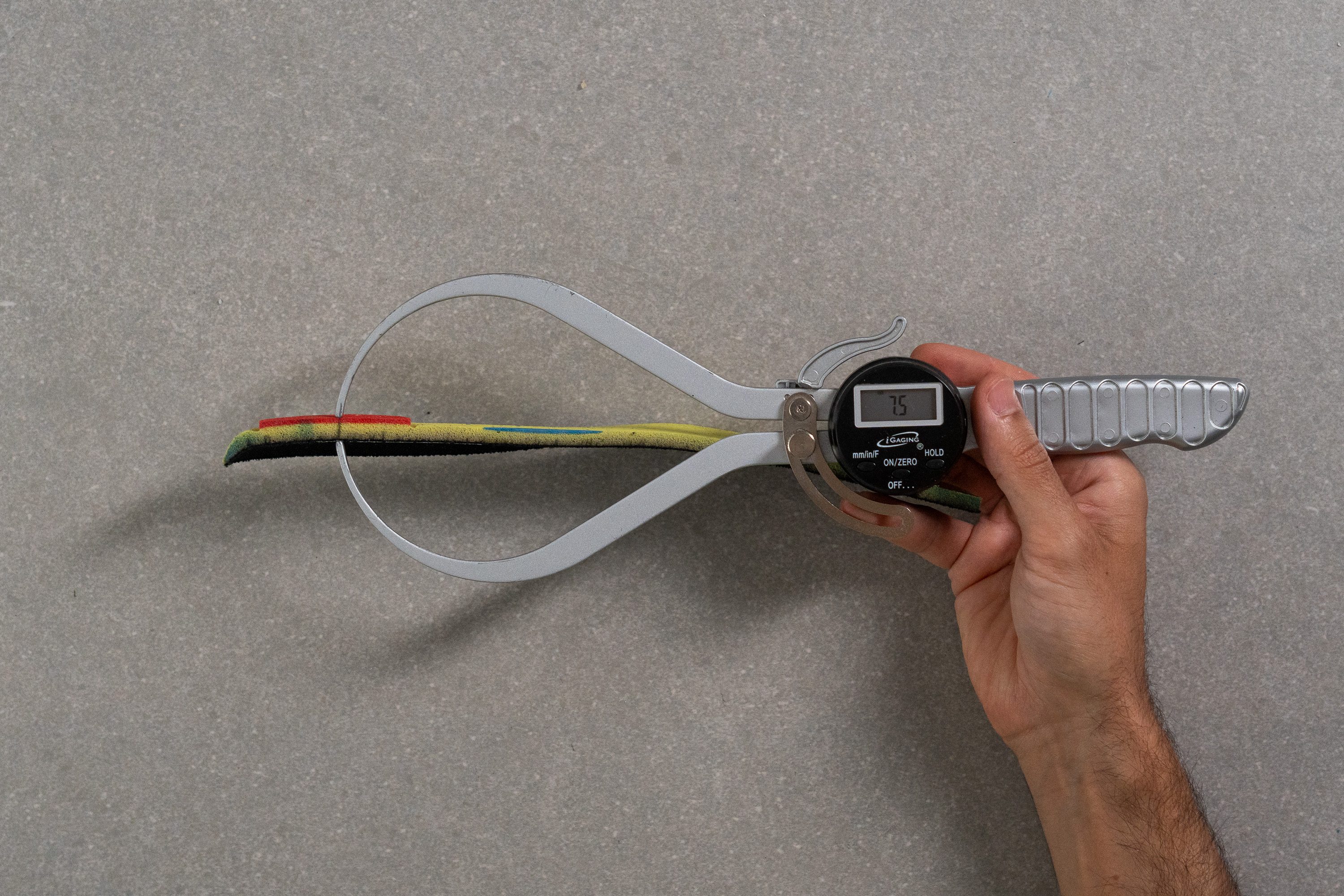
| Cellula | 7.5 mm |
| Average | 4.5 mm |
Removable insole
The stock insole is fully removable. This allows swapping it for a slimmer alternative from another shoe, which adds welcome room in an otherwise snug-fitting toebox.
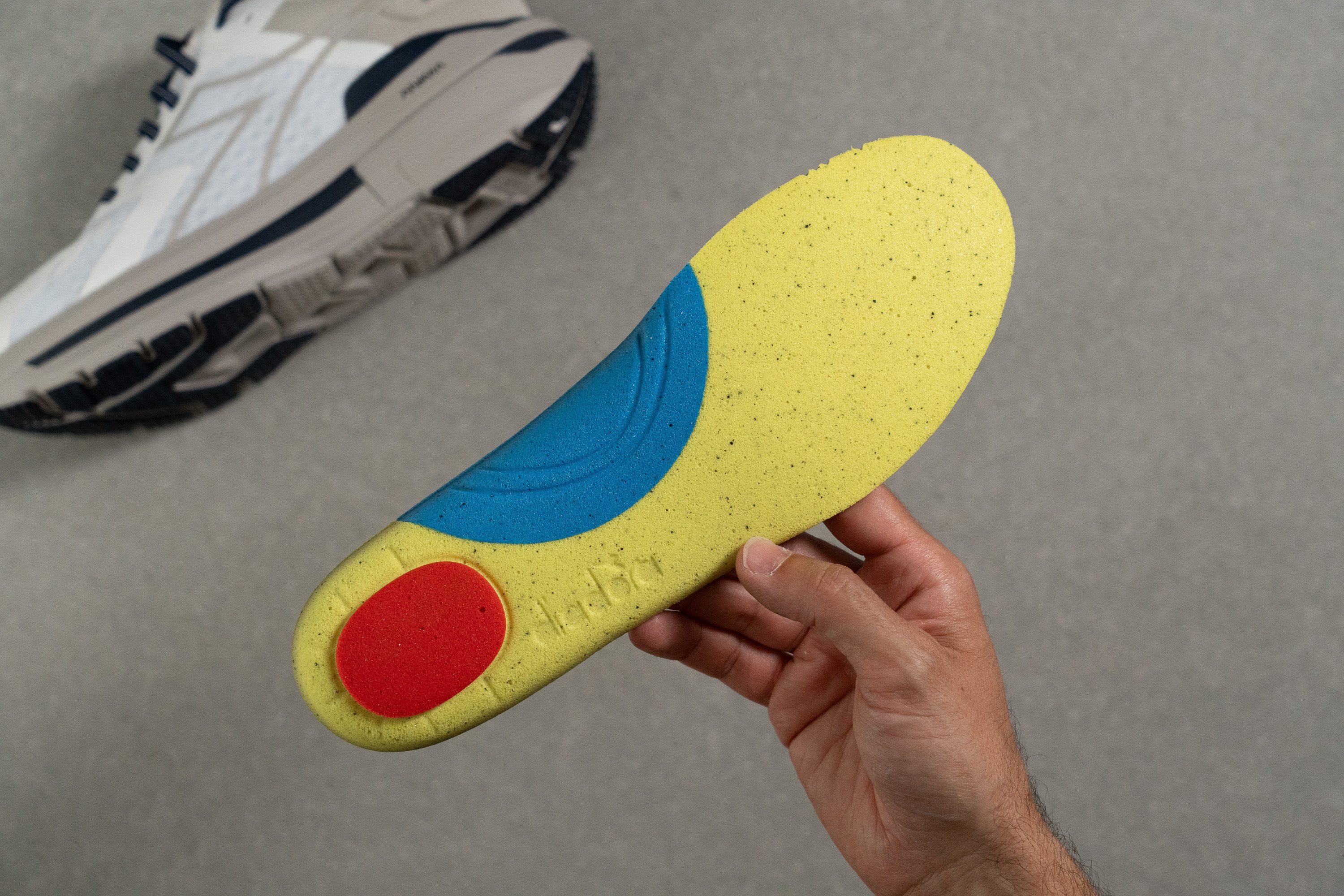
| Cellula | Yes |
Midsole softness in cold (%)
The ANIMA foam uses standard EVA, and as we confirmed in the lab, that typically means it turns brick-like in cold conditions. For the Cellula, the outcome was disappointing: a 52% increase in firmness after just 20 minutes in our freezer.
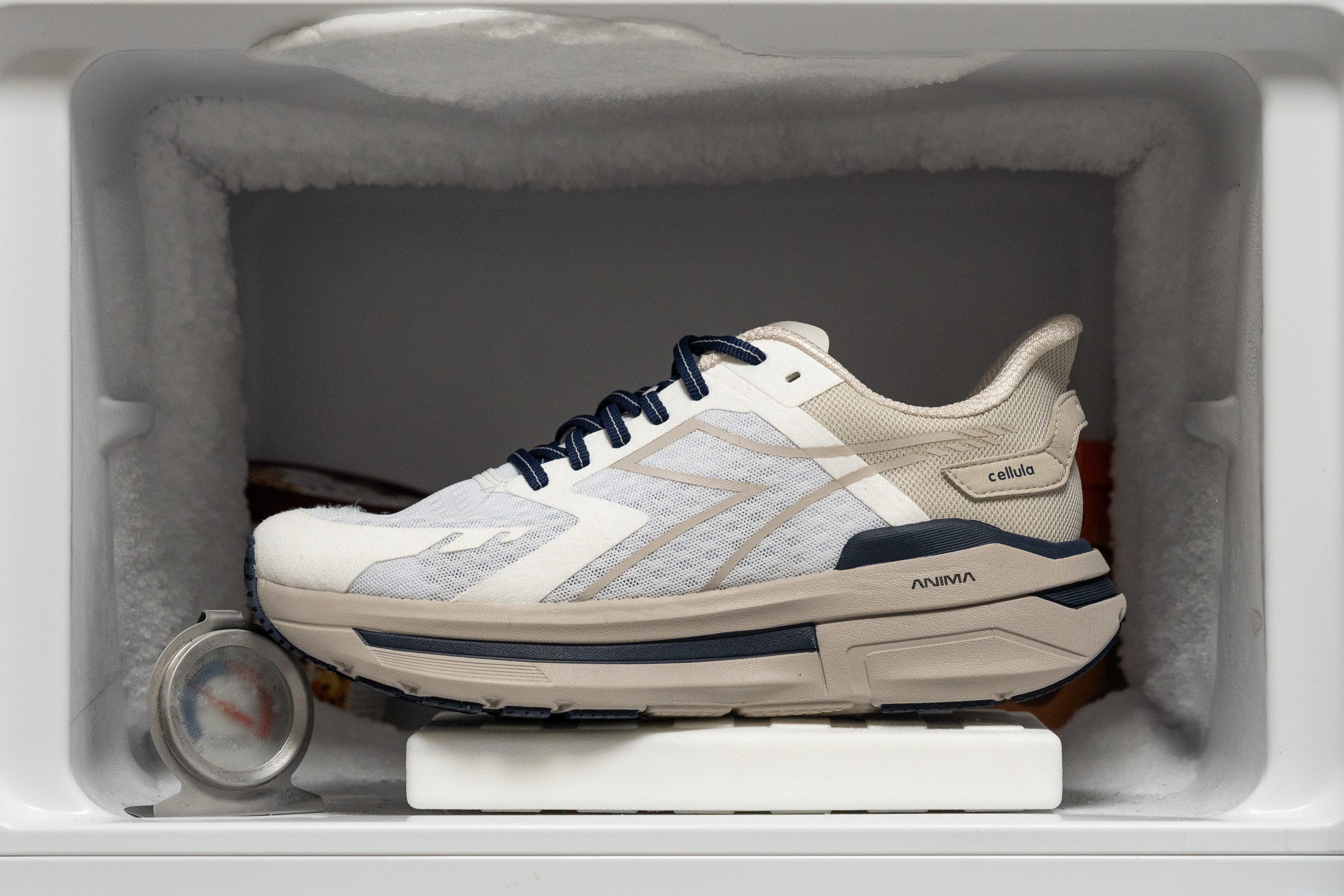
| Cellula | 52% |
| Average | 24% |
Reflective elements
Diadora added five small reflective dots to the finger-loop heel tab, which is really cool.
| Cellula | Yes |
Tongue padding
We found it fascinating that Diadora took the exact opposite approach with the Cellula’s tongue compared to the Atomo Star. Here, it’s a super-thin design with just 1.3 mm of padding, while its more expensive sibling boasts over 10 mm for an ultra-plush feel. Therefore, this shoe requires extra care each time you tighten the laces.
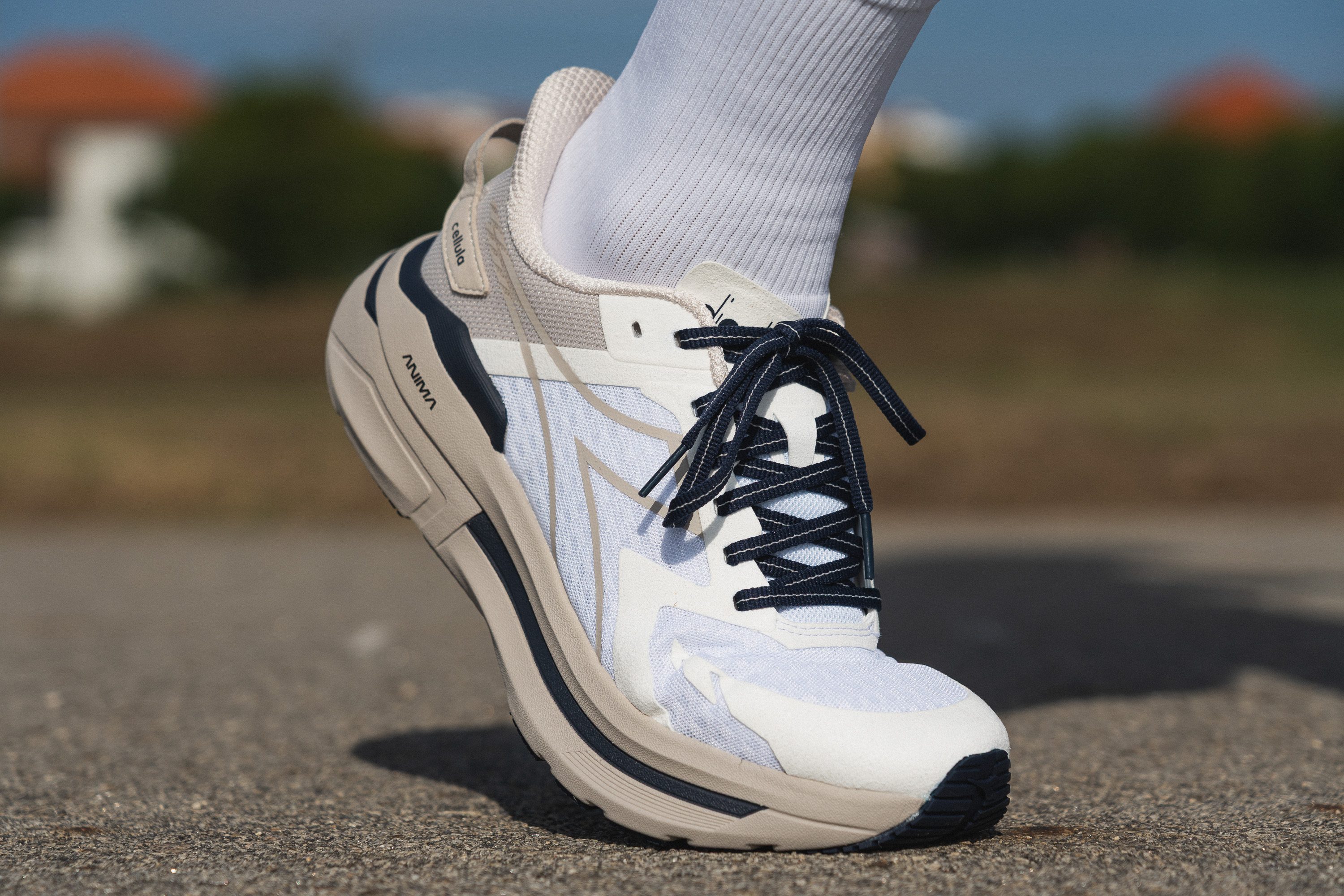
The lacing system is straightforward, consisting of punched eyelets plus an extra one at the top for those who prefer a runner’s knot. Everything is well crafted, and like the rest of the shoe, the materials and quality control are excellent.
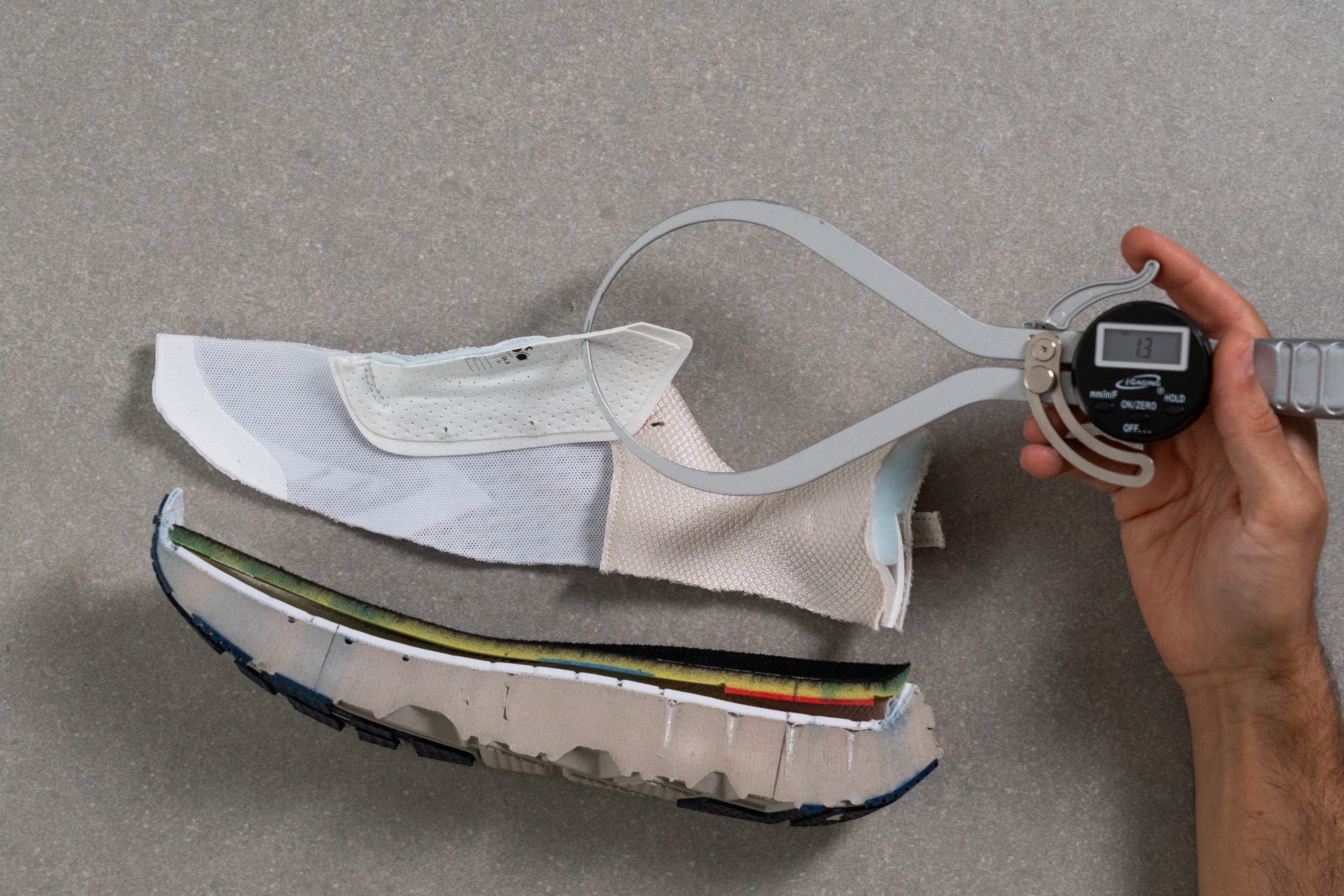
| Cellula | 1.3 mm |
| Average | 5.8 mm |
Tongue: gusset type
The tongue on the Cellula is not gusseted, which feels disappointing given its premium price. We believe a semi-gusseted design would have been a more fitting (and fair) choice for a shoe like this.
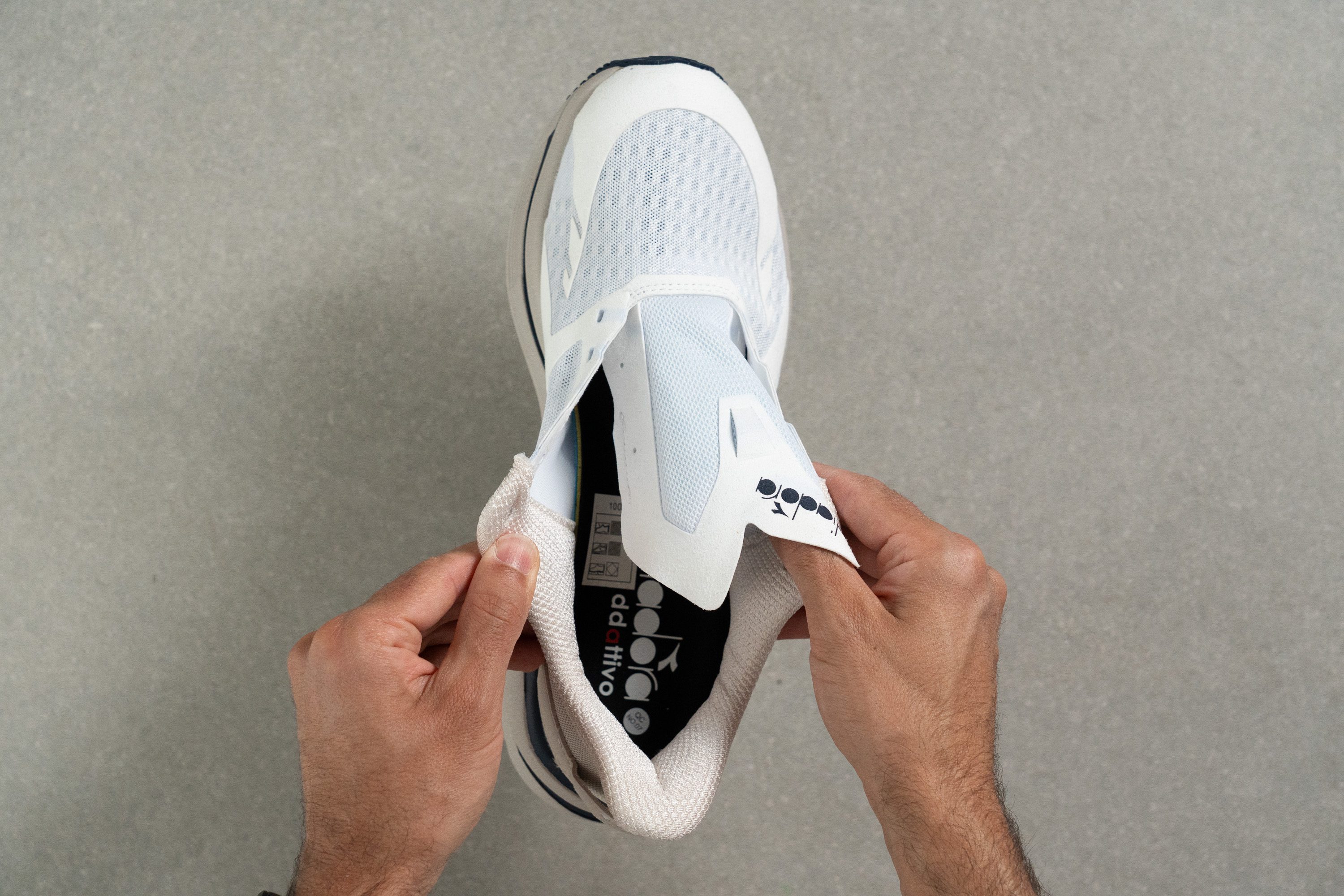
| Cellula | None |
Price
The Diadora Cellula lacks the “Made in Italy” tag found on other Diadora models and it's made in Vietnam, making its premium price harder to justify. Ultimately, much like Italian cars, the Cellula is a purchase driven more by passion than by pure logic.
| Cellula | $170 |
| Average | $152 |
Heel tab
The heel tab of the Cellula is crafted from a soft, suede-like material stitched securely onto the heel collar. It provides a practical grip point for easy on-and-off while complementing the shoe’s retro-modern design aesthetic.
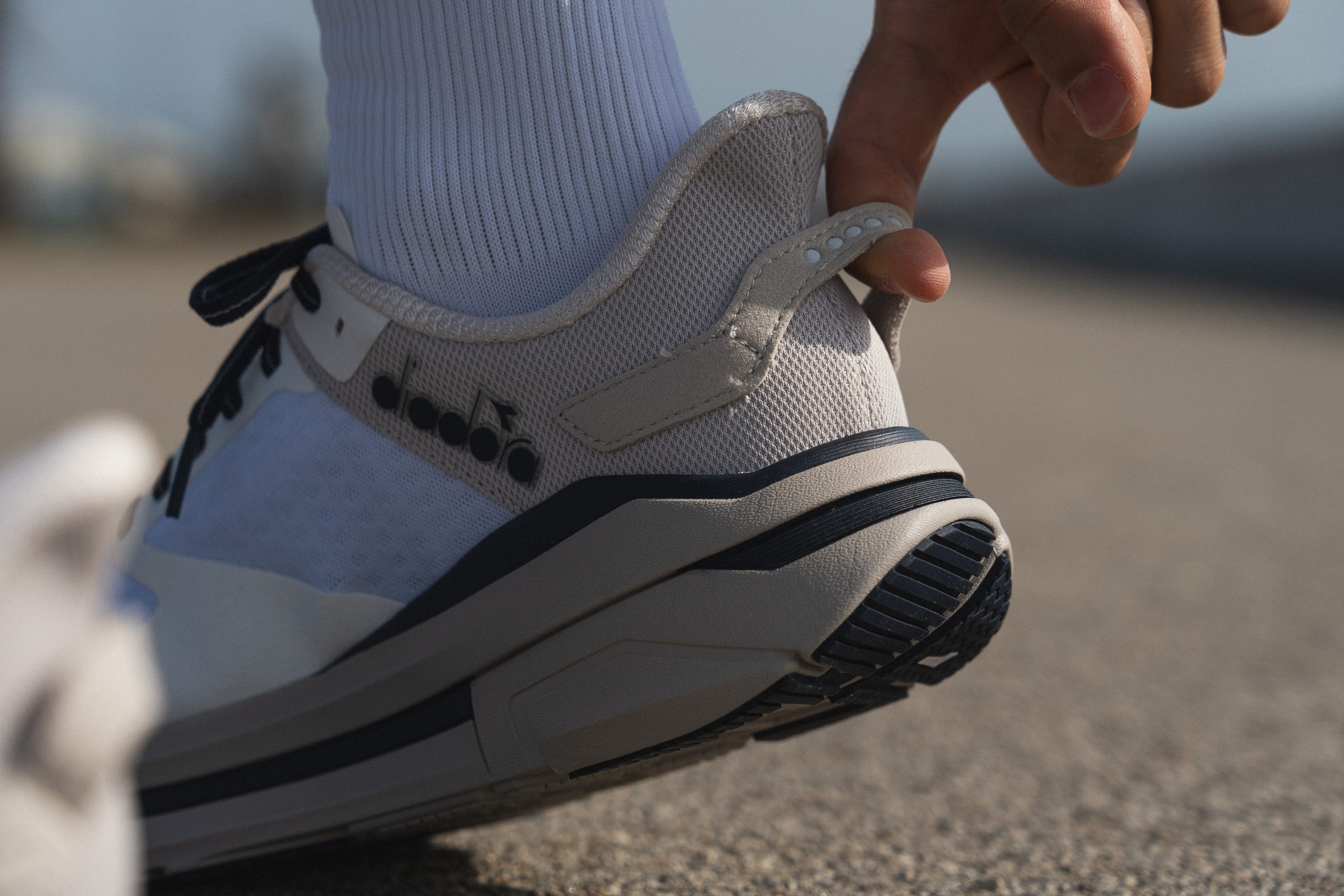
| Cellula | Finger loop |

